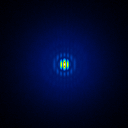 | 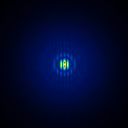 | 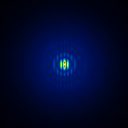 |
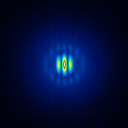 | 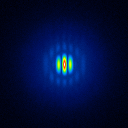 | 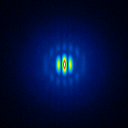 |
This test investigates the dependency of the reconstruction error on the spectra of the target and calibrator. For this test, the PSFs are generated using several (10) monochromatic PSFs. For the target and calbrator a linear spectrum was assumed. The simple case of a constant target and calibrator spectrum was used as a comparison to the monochromatic case (see section Dependency on the strehl deviation). In addition, a very red target (0.5 mag brighter in the red) and a few slightly red calibrators (0.1 mag and 0.2 mag brighter in the red) were used.
The setup of the simulation is described in table 1. The input data for the test uses a strehl value of 0.30 for target and calibrator. The psf star has a magnitude of 14. In addition, the target and psf star PSF are generated by using 10 monochromatic PSFs.
The multi-monochromatic PSFs are created by generating a monochromatic OPD screen for the shortest wavelength λ0. The OPD values are rescaled for a given wavelength λ (we used 10 discrete wavelength to sample a spectral band) by λ0/λ. The result was put into an array which was enlarged by λ/λ0. A PSF for a specific wavelength was then calculated by |FFT-1|2, weighted by the spectral intensity and all summed up to the final multi-monochromatic PSF.
| Parameter | Description |
|---|---|
| Atmosphere/AO | The AO delivers a strehl of about 30 percent for the target and the psf star. The psfs are separately simulated and therefore not equal! |
| Spectra | The target and calibrator show a linear spectra which was sampled at 10 equally spaced wavelength over the J-Band (1.1 - 1.3 μm) and K-Band (2.0 - 2.4 μm). The spectrum of the target was 0.0 or 0.5 mag brighter in the red and for the calibrator, a spectra 0.0, 0.1, and 0.2 mag brighter in the red was used. |
| Observation | The observation target is NGC4151 with an overlayed dust tori (simulated) at 10.1mag integral brightness. The brightness of the psf-star is set to 14mag. For each position angle (108, 144, 180, 216, 252 degree) an image equivalent to 60s exposure time was created. The central wavelength was 1.2 micron (whole J-Band) and 2.2 micron (whole K-band). |
The raw data were generated according to the common scheme described in section Overview. In addition, the target and psf star PSF are generated by using 10 monochromatic PSFs.
All simulated input data for the LN DRS pipeline are available as a tar-file (ex6_j_input.tar.gz (3.9MB) and ex6_k_input.tar.gz (4.3MB)). The corresponding results are also available as tar files (ex6_j_results.tar.gz (552KB) and ex6_k_results.tar.gz (546KB)).
The generated calibrator raw images are shown in section Calibrator. The raw images and deconvolution results are shown in section Raw Frames and Results for an AGN for the AGN and section Raw Frames and Results for a Star Cluster for the star cluster.
The simulated raw LBT interferograms used for the deconvolution are ideal images, they are not influenced by detector effects like different pixel gain or bad pixels. In figure 1 the raw calibrator for different spectra are shown.
 |  |  |
 |  |  |
The basis of the simulation is an image of NGC4151 with an overlayed dust torus (see figure 1. The simulated raw images for a position angle of 108 degree are shown in figure 2.
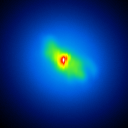 | 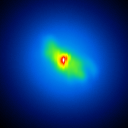 |
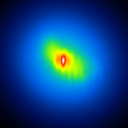 | 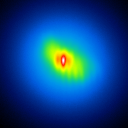 |
A comparison of the reconstructions depending on the spectra is presented in figure 3 (J-Band) in figure 4 (K-Band).
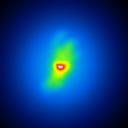 |  | 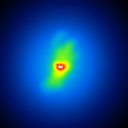 |  |
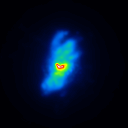 | 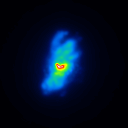 | 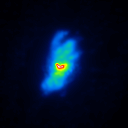 | 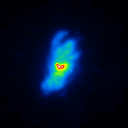 |
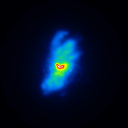 | 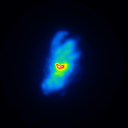 | 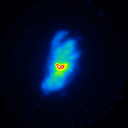 | 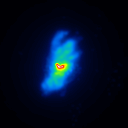 |
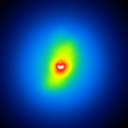 |  | 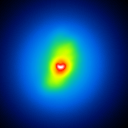 |  |
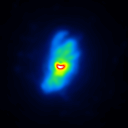 | 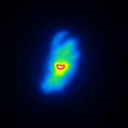 | 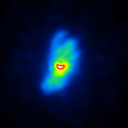 | 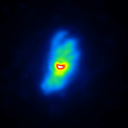 |
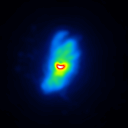 | 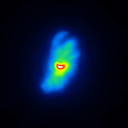 | 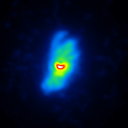 | 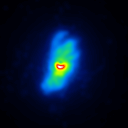 |
In figure 5 the image error describing the difference between the reconstruction and the reference image is shown for each iteration (in steps of 100 iterations). The effect of the target and calibrator spectrum on the reconstruction error and the optimal iteration number is clearly visible.
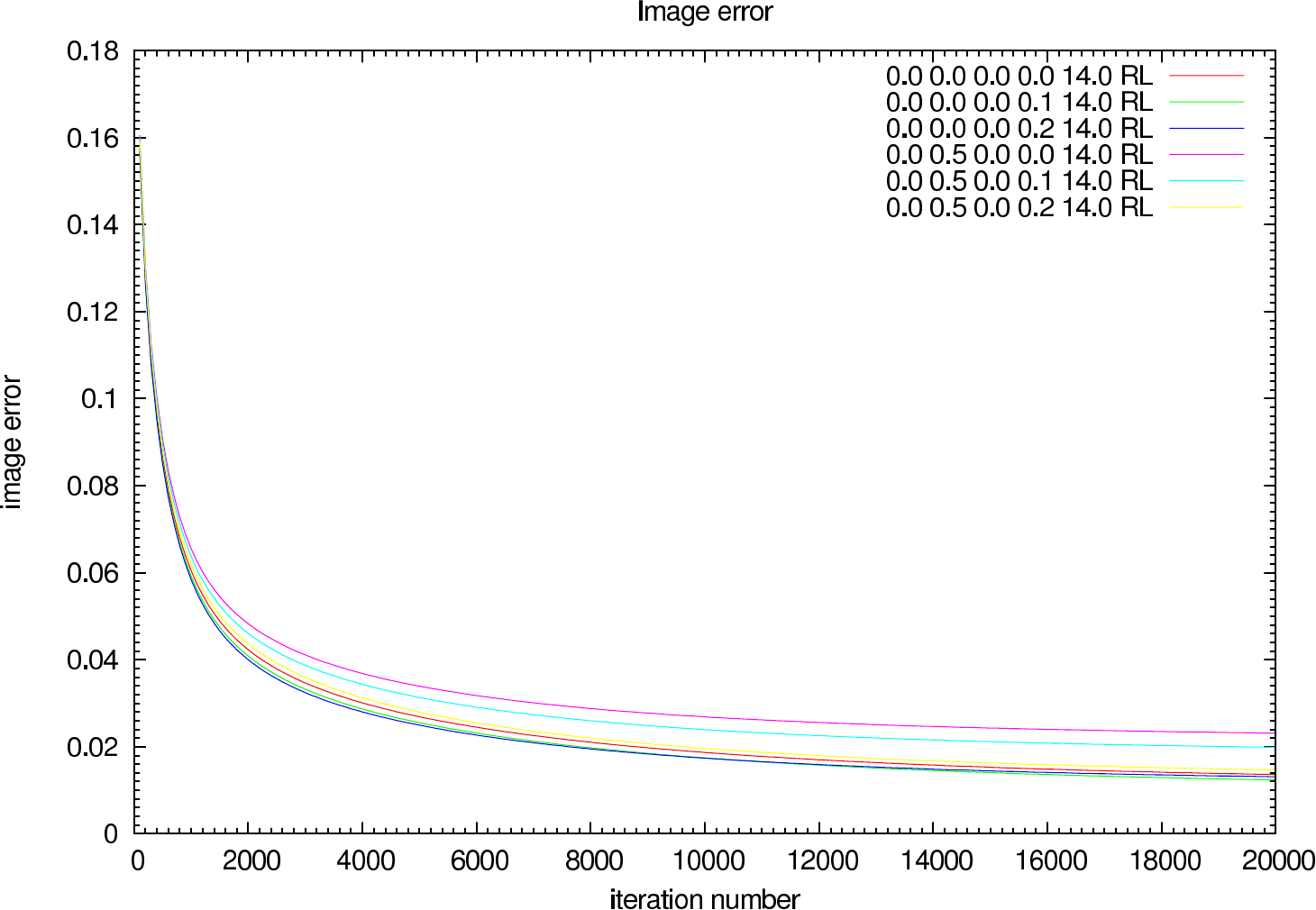 | 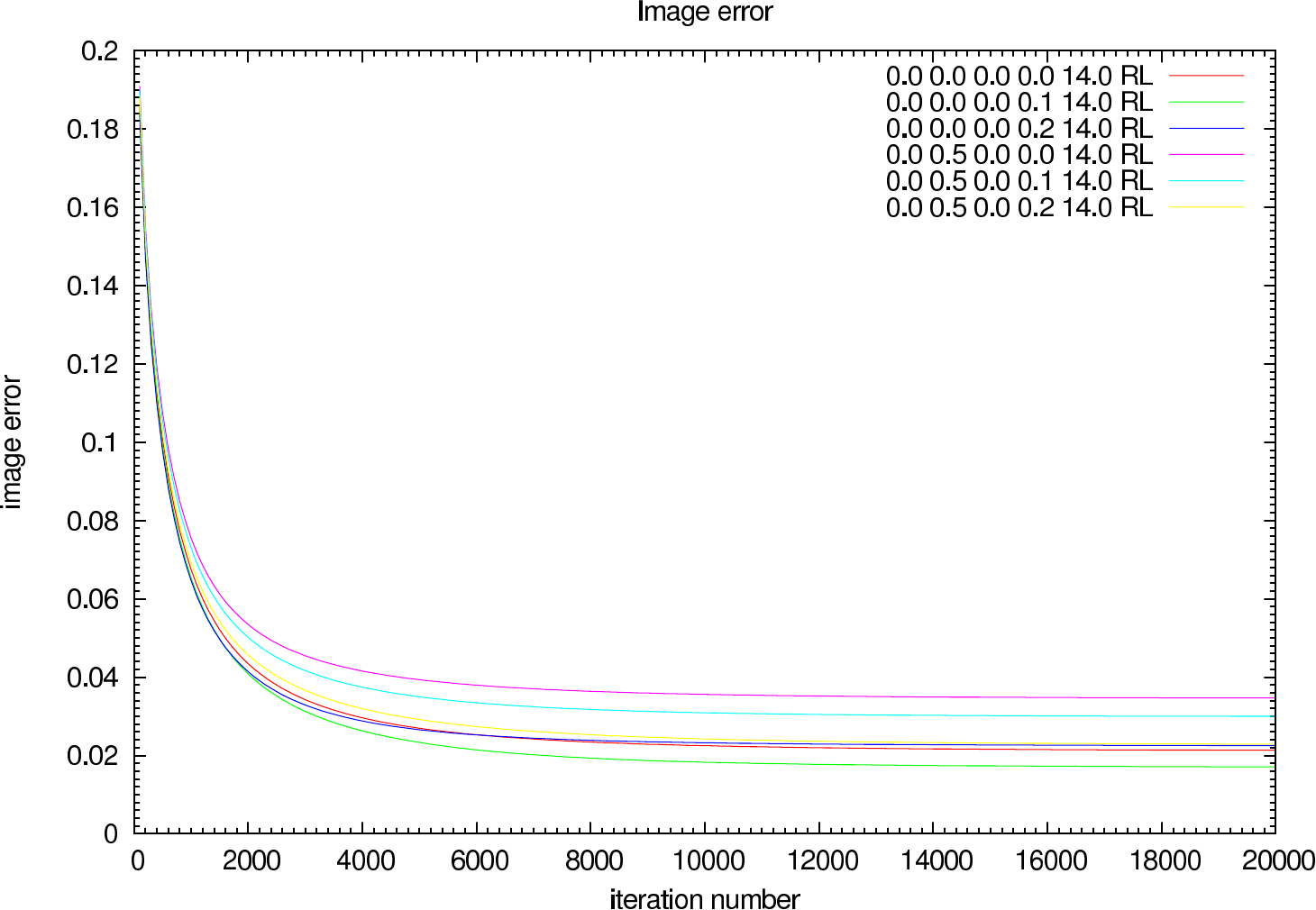 |
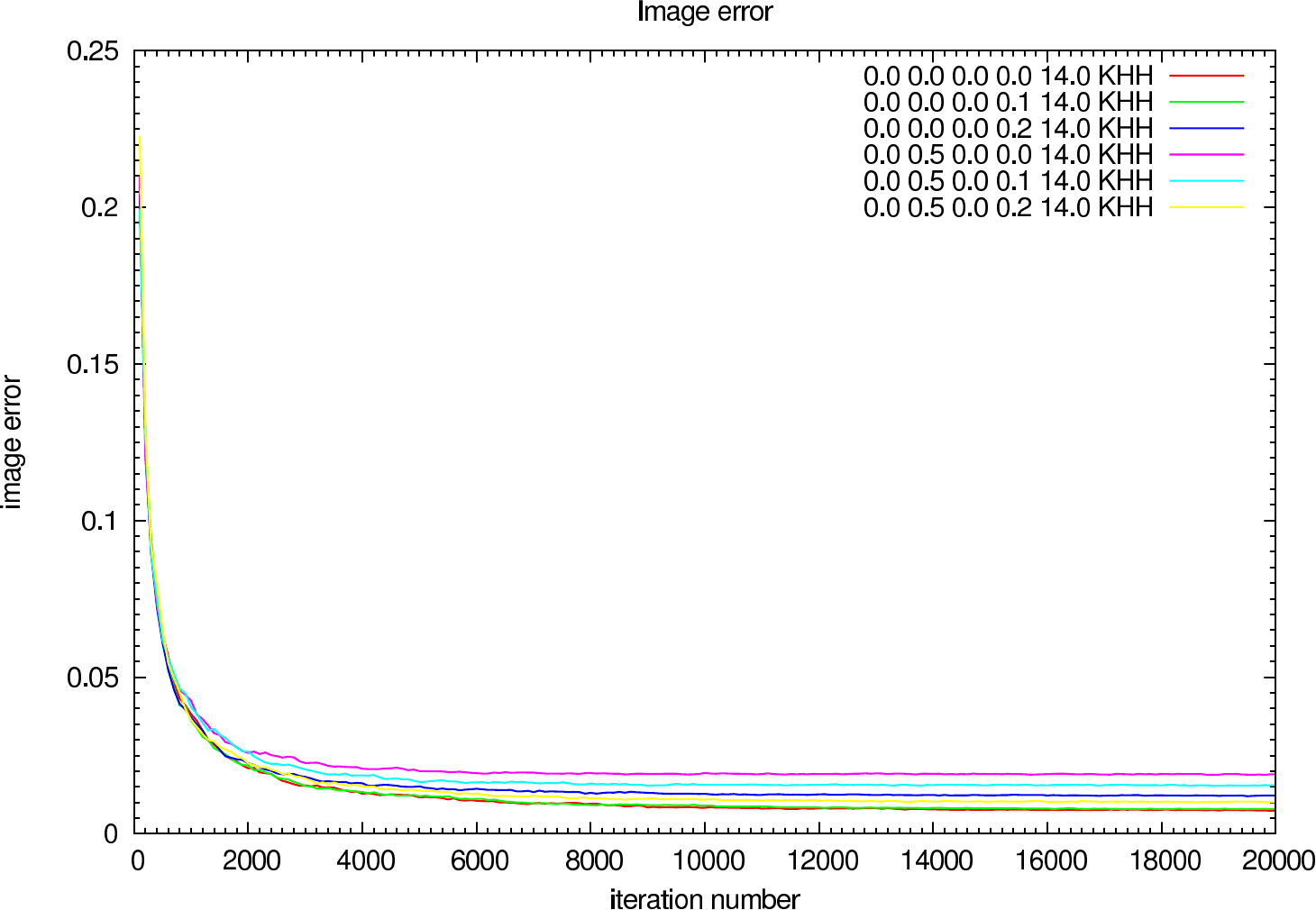 | 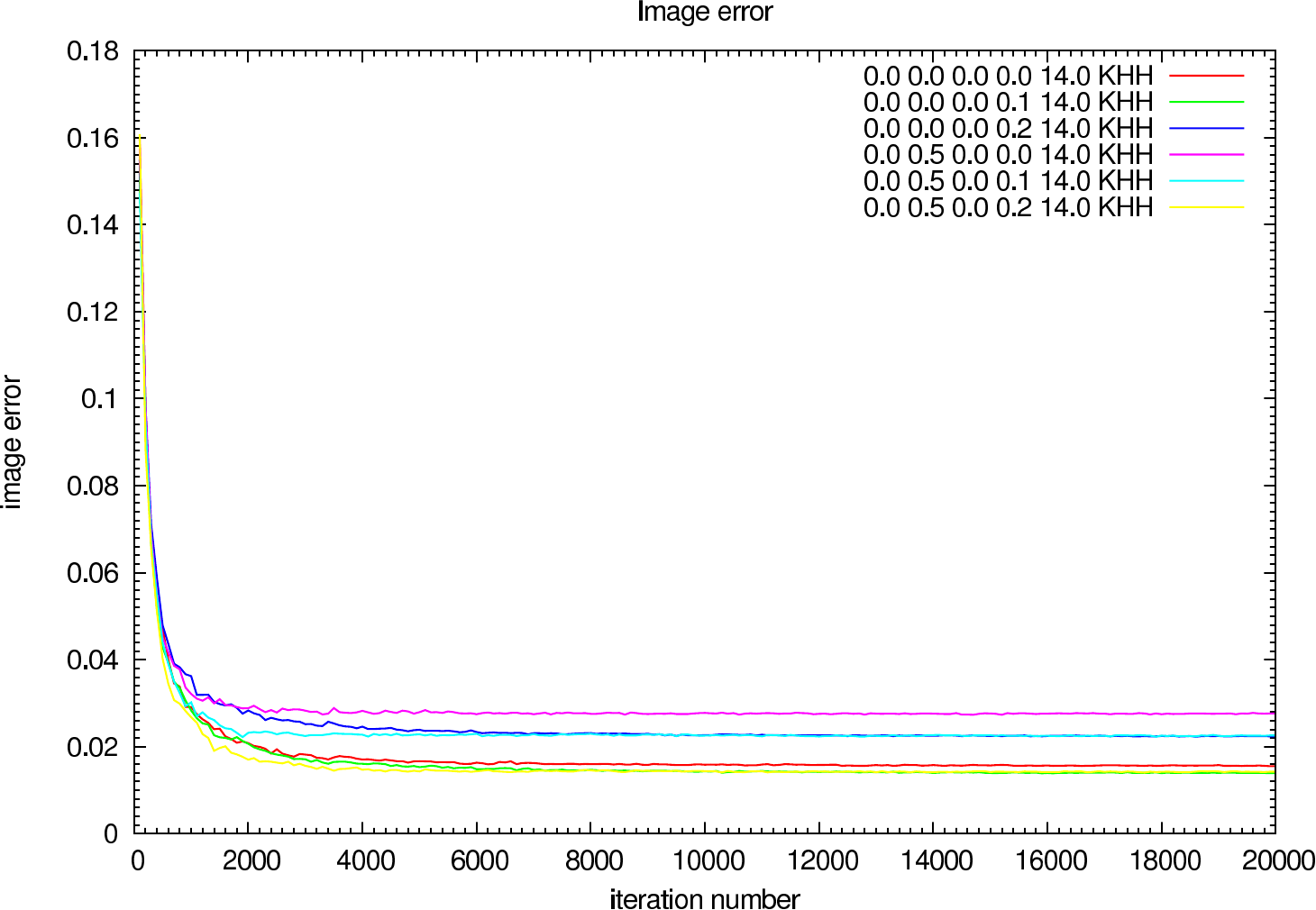 |
In figure 6 (J-Band) and figure 7 (K-Band) a horizontal cut slightly above the intensity maximum of the reconstructions of NHC4151 compared with the ideal reference image is shown.
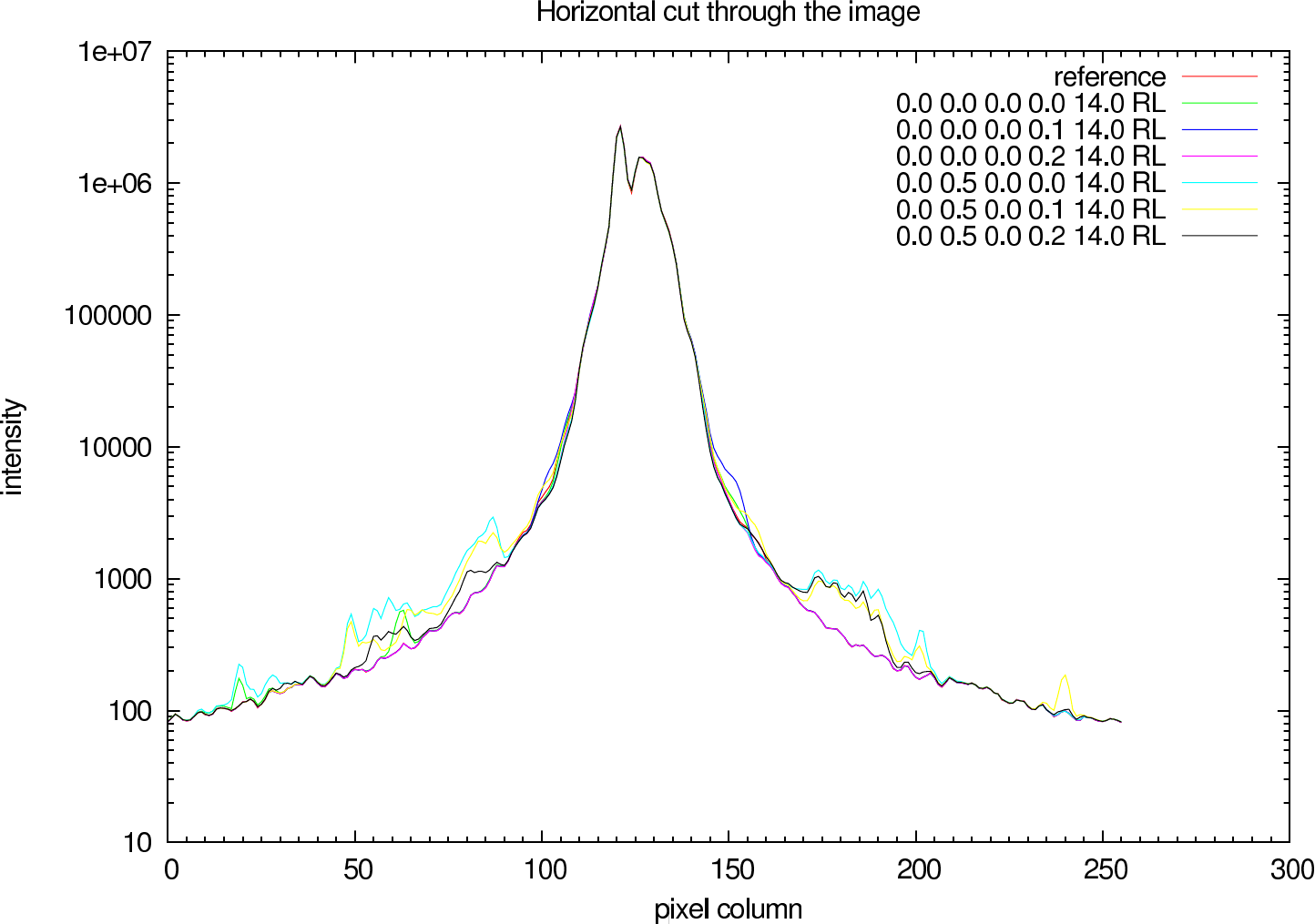 | 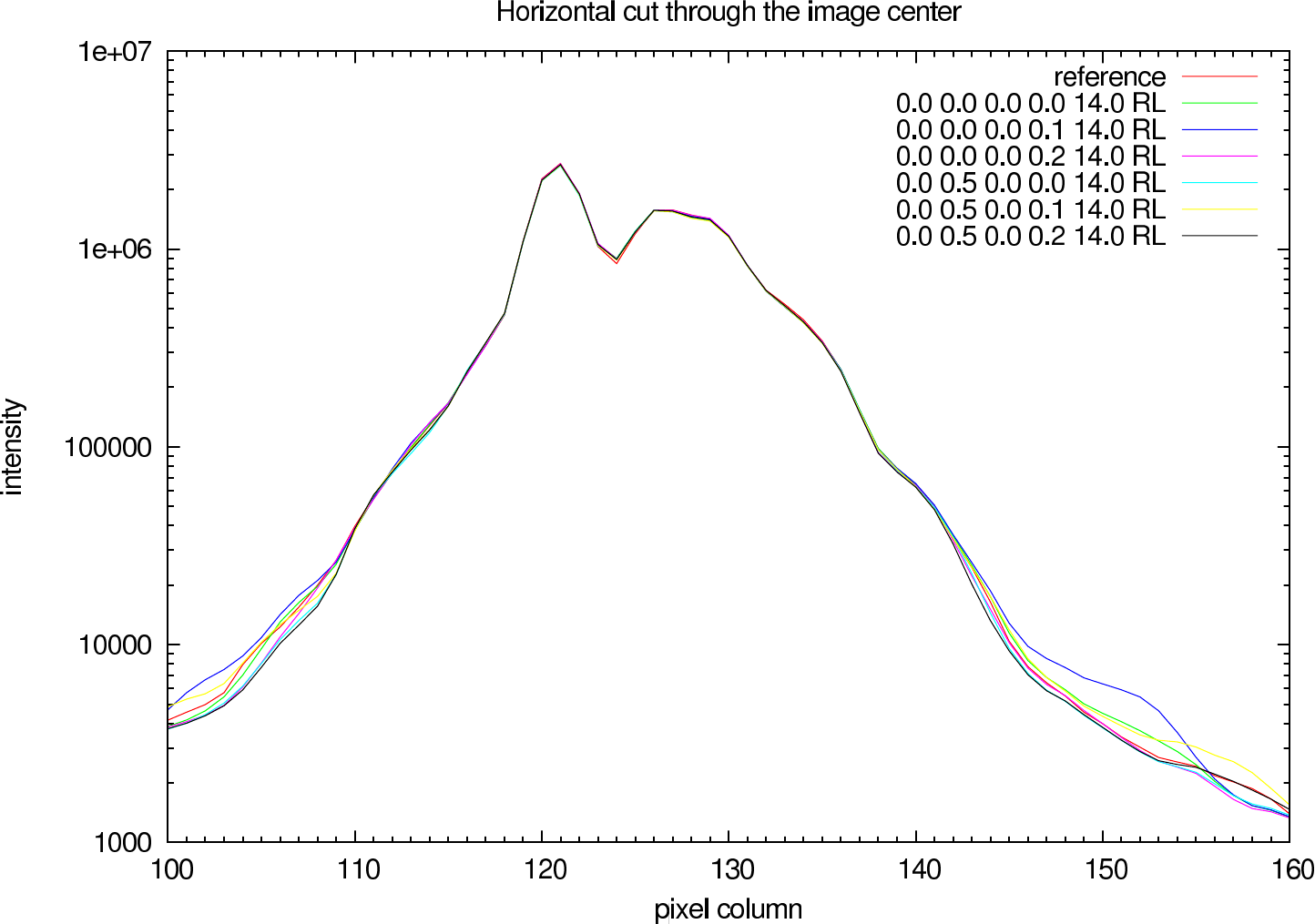 |
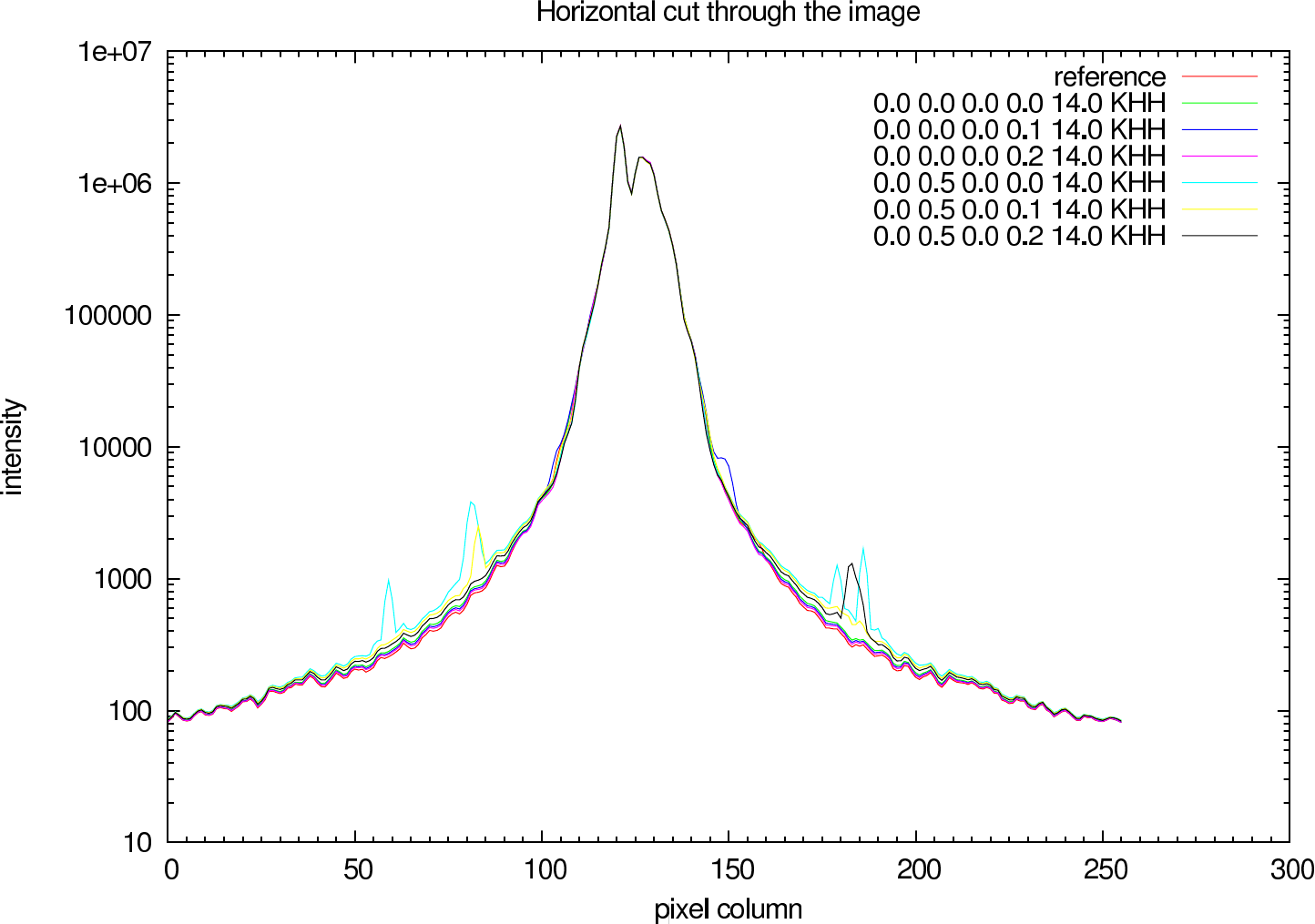 | 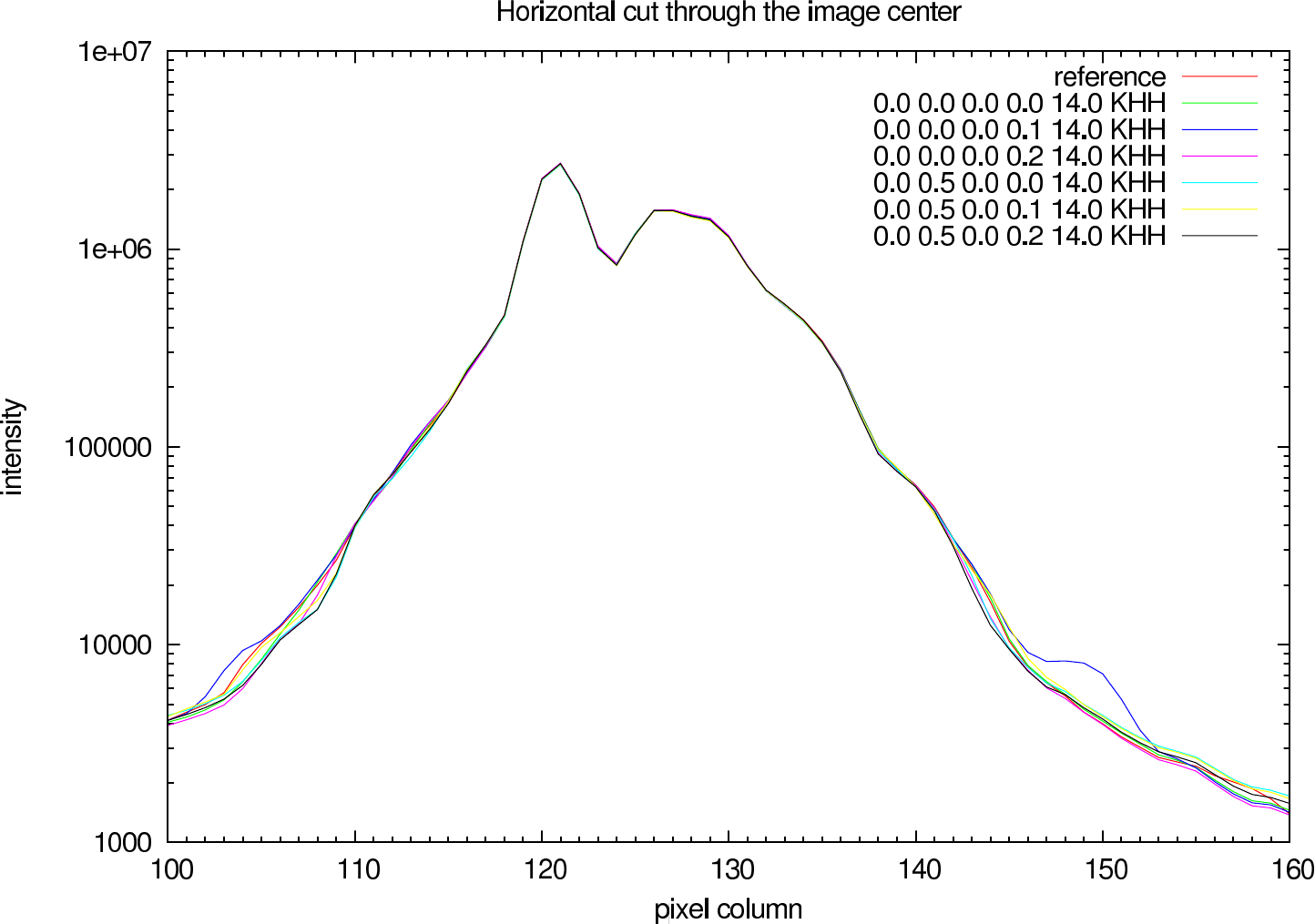 |
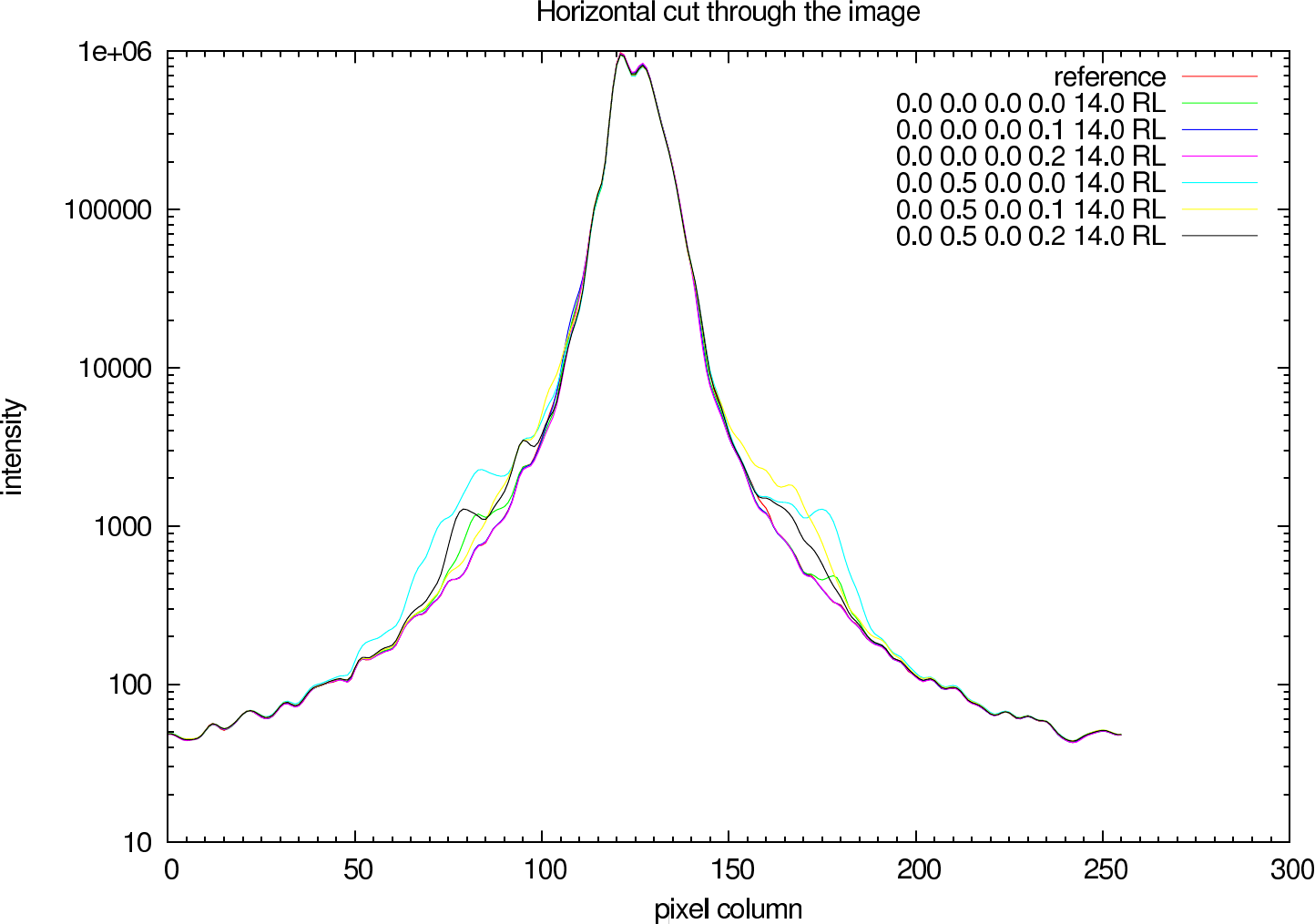 | 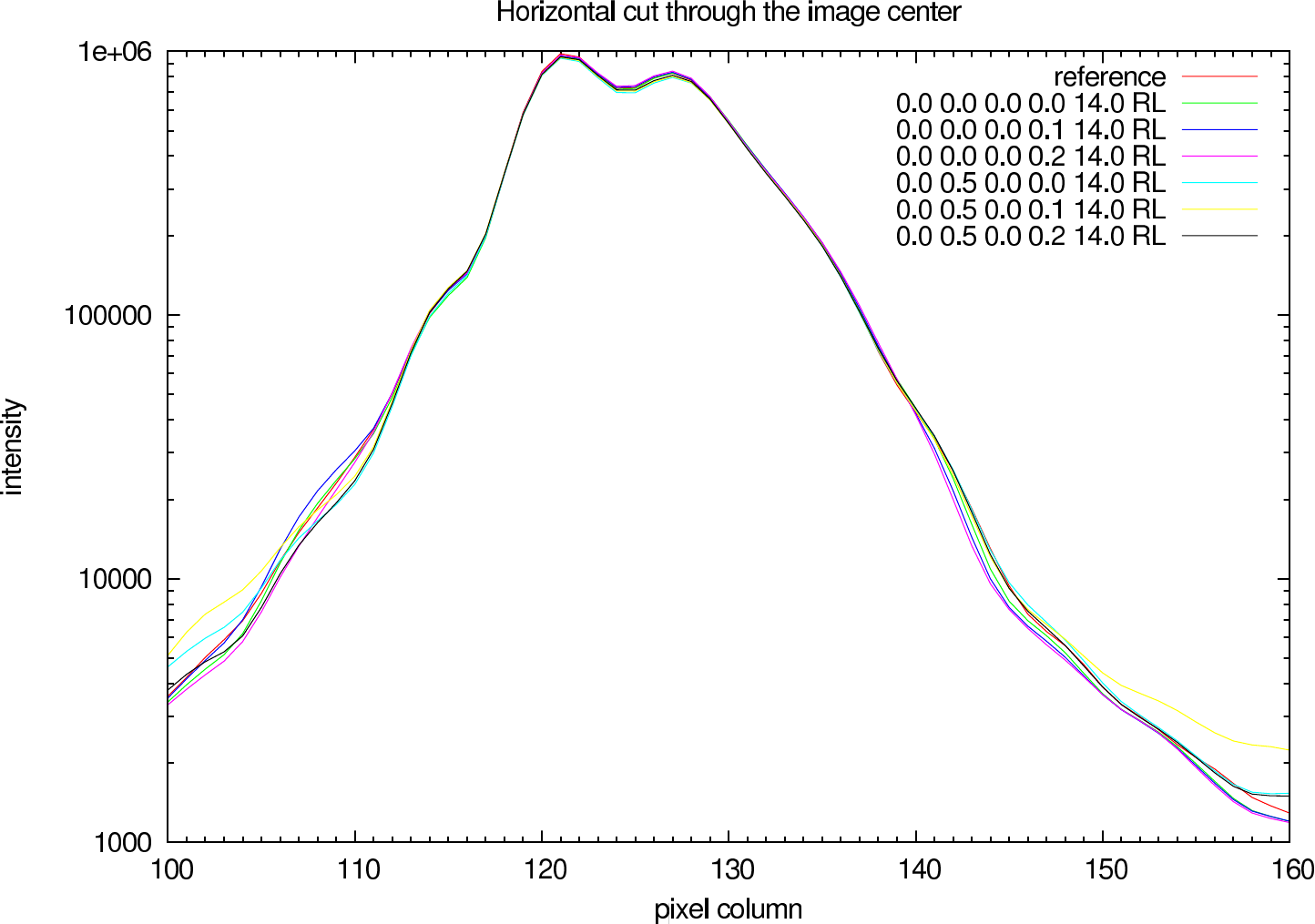 |
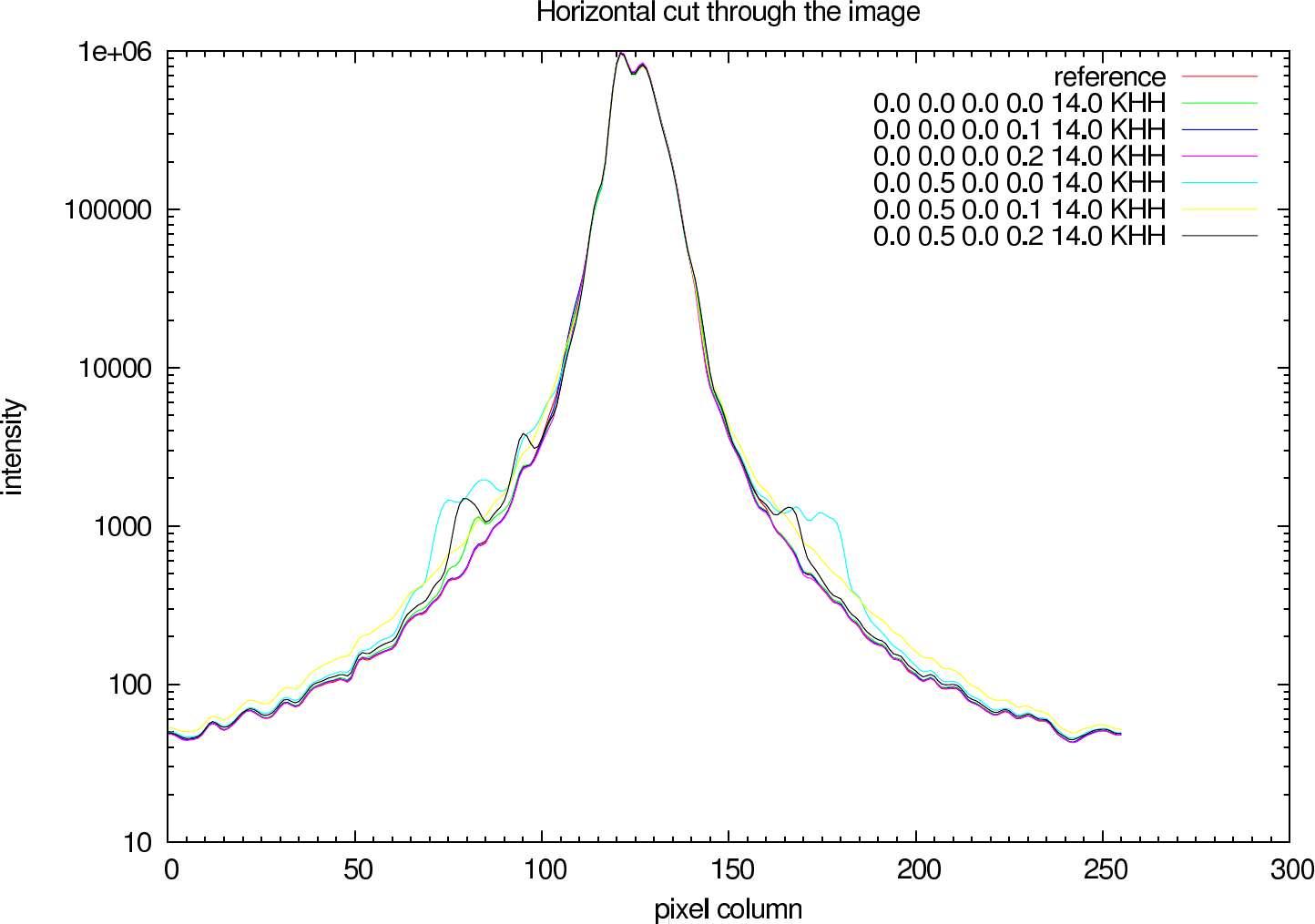 | 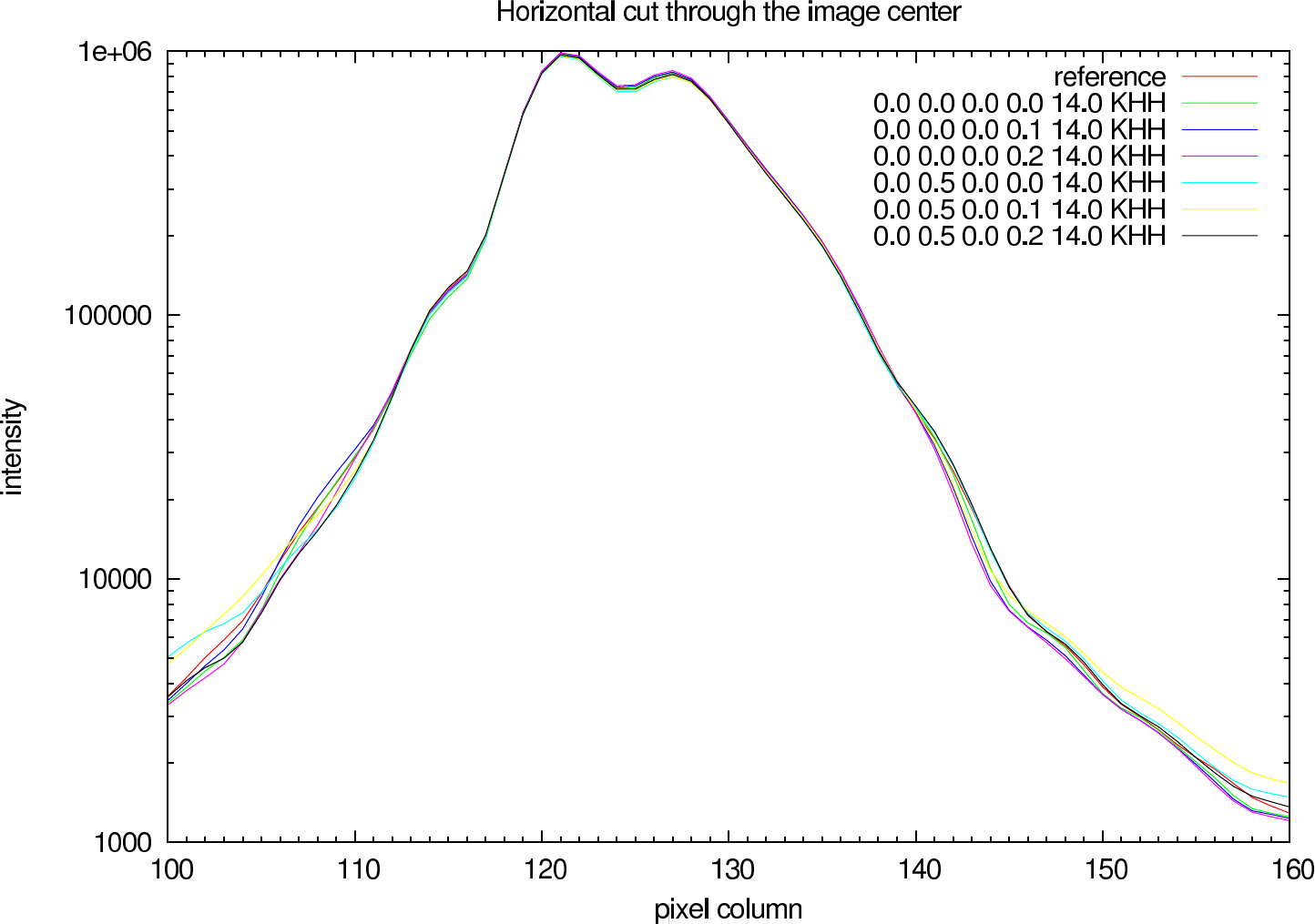 |
In table 2 (J-Band) and table 3 (K-Band) the errors for the star cluster depending on the target and calibrator spectrum are presented.
| Testcase | Richardson-Lucy | Building-Block | |
|---|---|---|---|
| Spectrum (T) | Spectrum (C) | Image Error | Image Error |
| 0.0 0.0 | 0.0 0.0 | 0.014 (0.014) | 0.007 (0.007) |
| 0.0 0.0 | 0.0 0.1 | 0.012 (0.012) | 0.008 (0.008) |
| 0.0 0.0 | 0.0 0.2 | 0.013 (0.013) | 0.012 (0.012) |
| 0.0 0.5 | 0.0 0.0 | 0.023 (0.023) | 0.019 (0.019) |
| 0.0 0.5 | 0.0 0.1 | 0.020 (0.020) | 0.015 (0.015) |
| 0.0 0.5 | 0.0 0.2 | 0.015 (0.015) | 0.010 (0.010) |
| Testcase | Richardson-Lucy | Building-Block | |
|---|---|---|---|
| Spectrum (T) | Spectrum (C) | Image Error | Image Error |
| 0.0 0.0 | 0.0 0.0 | 0.021 (0.021) | 0.016 (0.016) |
| 0.0 0.0 | 0.0 0.1 | 0.017 (0.017) | 0.014 (0.014) |
| 0.0 0.0 | 0.0 0.2 | 0.023 (0.023) | 0.022 (0.022) |
| 0.0 0.5 | 0.0 0.0 | 0.035 (0.035) | 0.027 (0.027) |
| 0.0 0.5 | 0.0 0.1 | 0.030 (0.030) | 0.022 (0.022) |
| 0.0 0.5 | 0.0 0.2 | 0.023 (0.023) | 0.014 (0.014) |
The basis of the simulation is an image of a starcluster (see figure 2. The simulated raw images for a position angle of 108 degree are shown in figure 2.
 |  |
 |  |
A comparison of the reconstructions depending on the spectra is presented in figure 9 (J-Band) in figure 10 (K-Band).
 |  |  |  |
 |  |  |  |
 |  |  |  |
 |  |  |  |
 |  |  |  |
 |  |  |  |
In figure 11 the image error describing the difference between the reconstruction and the reference image is shown for each iteration (in steps of 100 iterations). The effect of the target and calibrator spectrum on the reconstruction error and the optimal iteration number is clearly visible.
 |  |
 |  |
In the figures figure 12, figure 13, figure 14, and figure 15 the image and photometric errors depending on the spectra and the iteration number is shown.
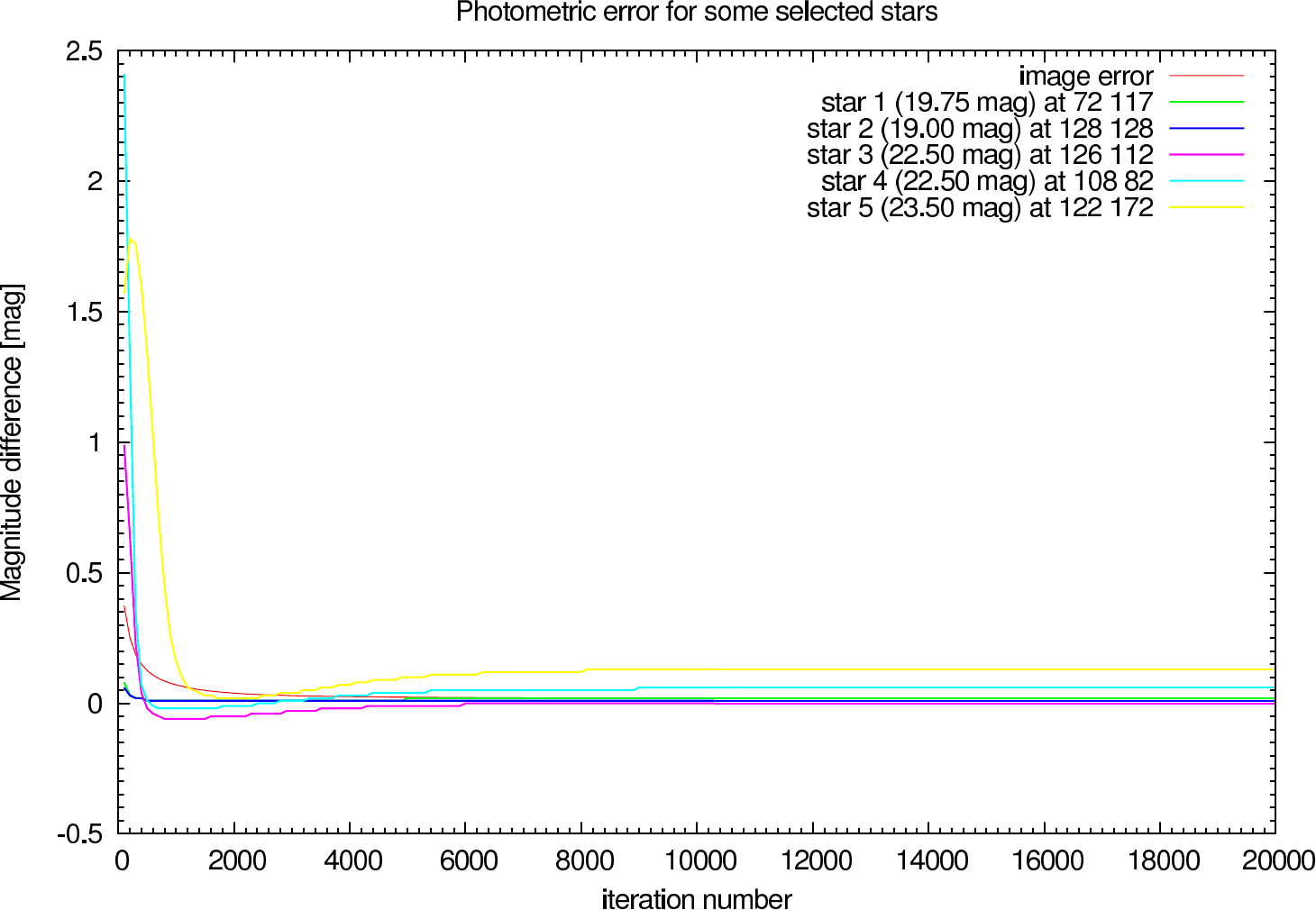 | 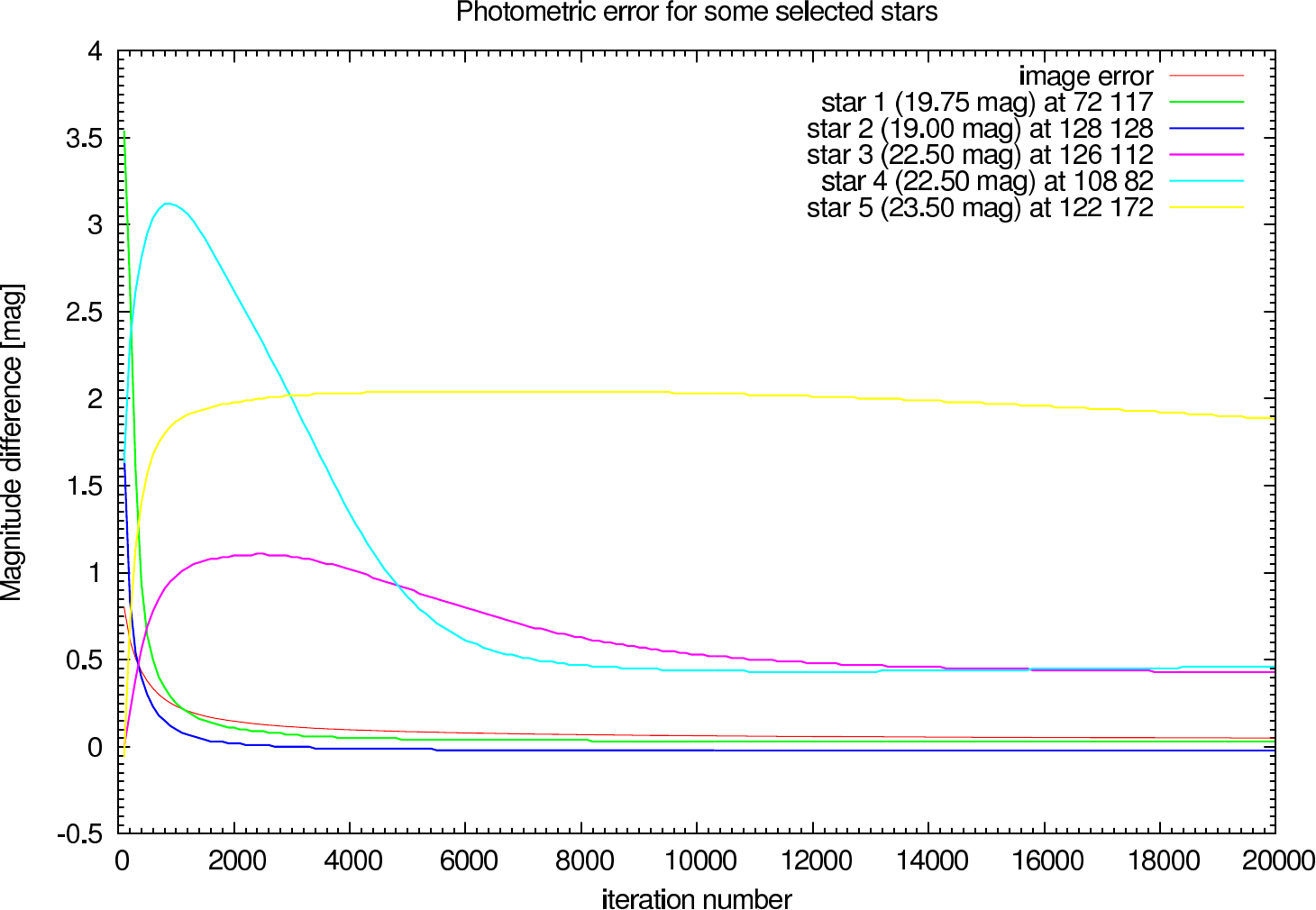 |
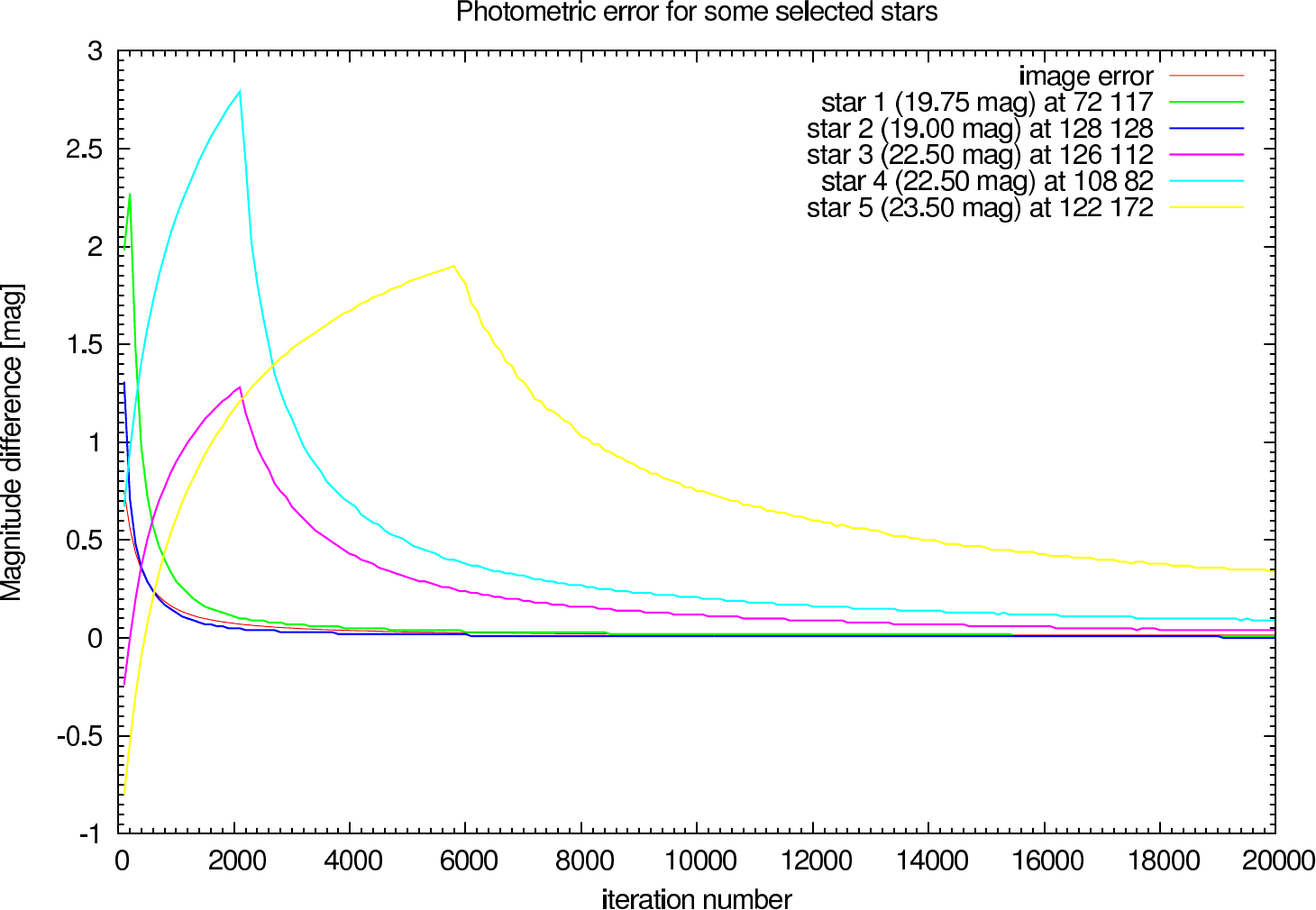 | 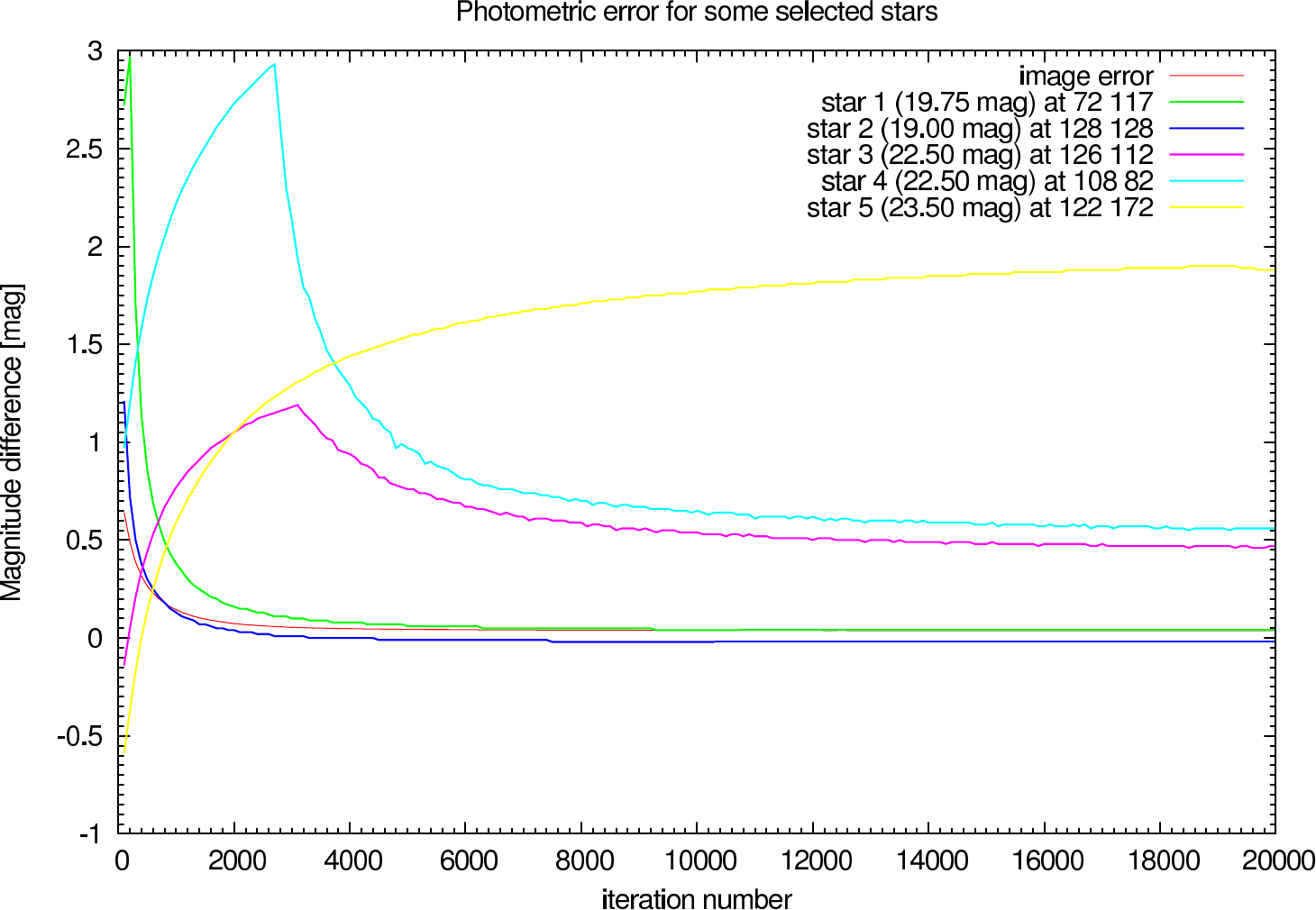 |
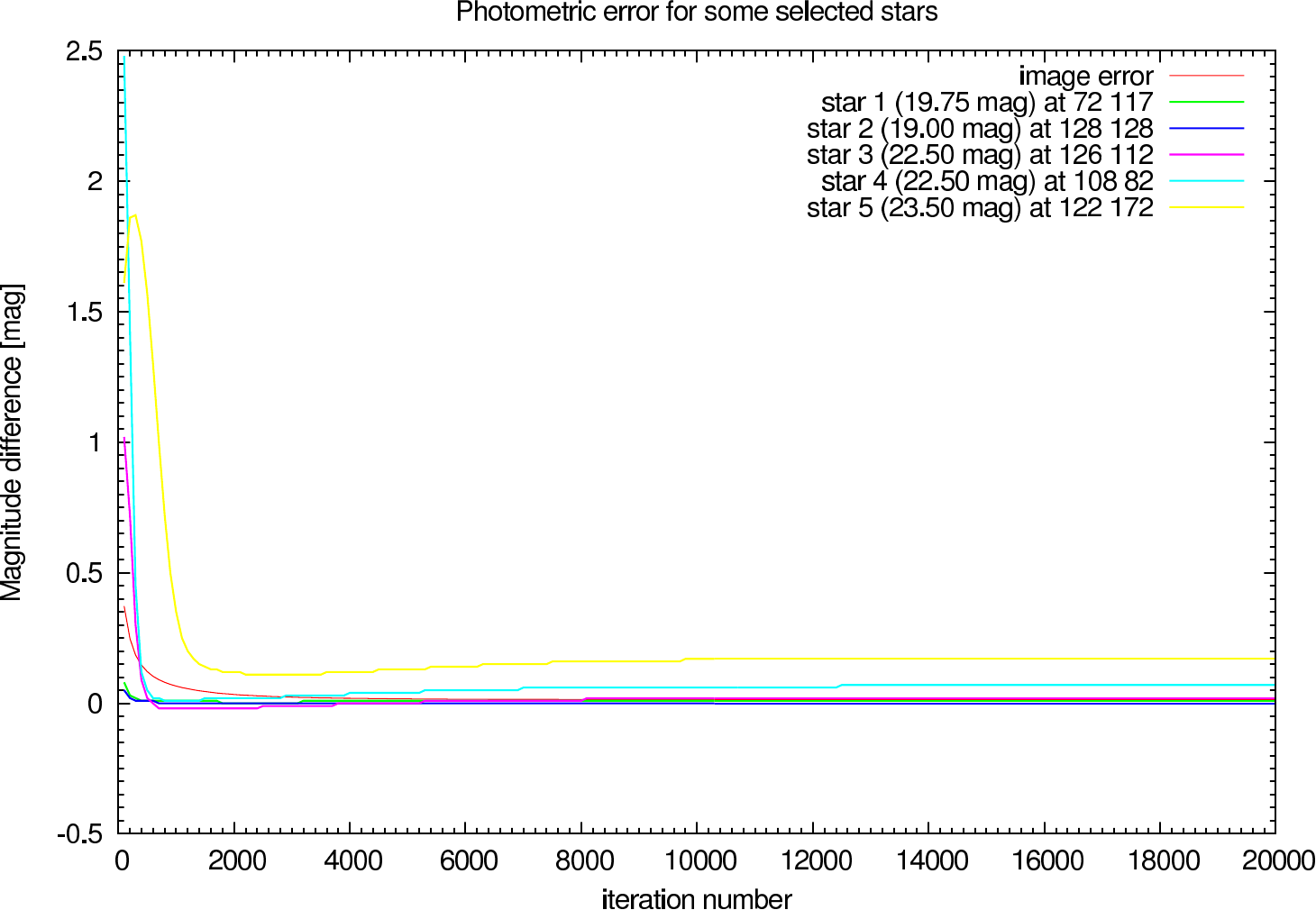 | 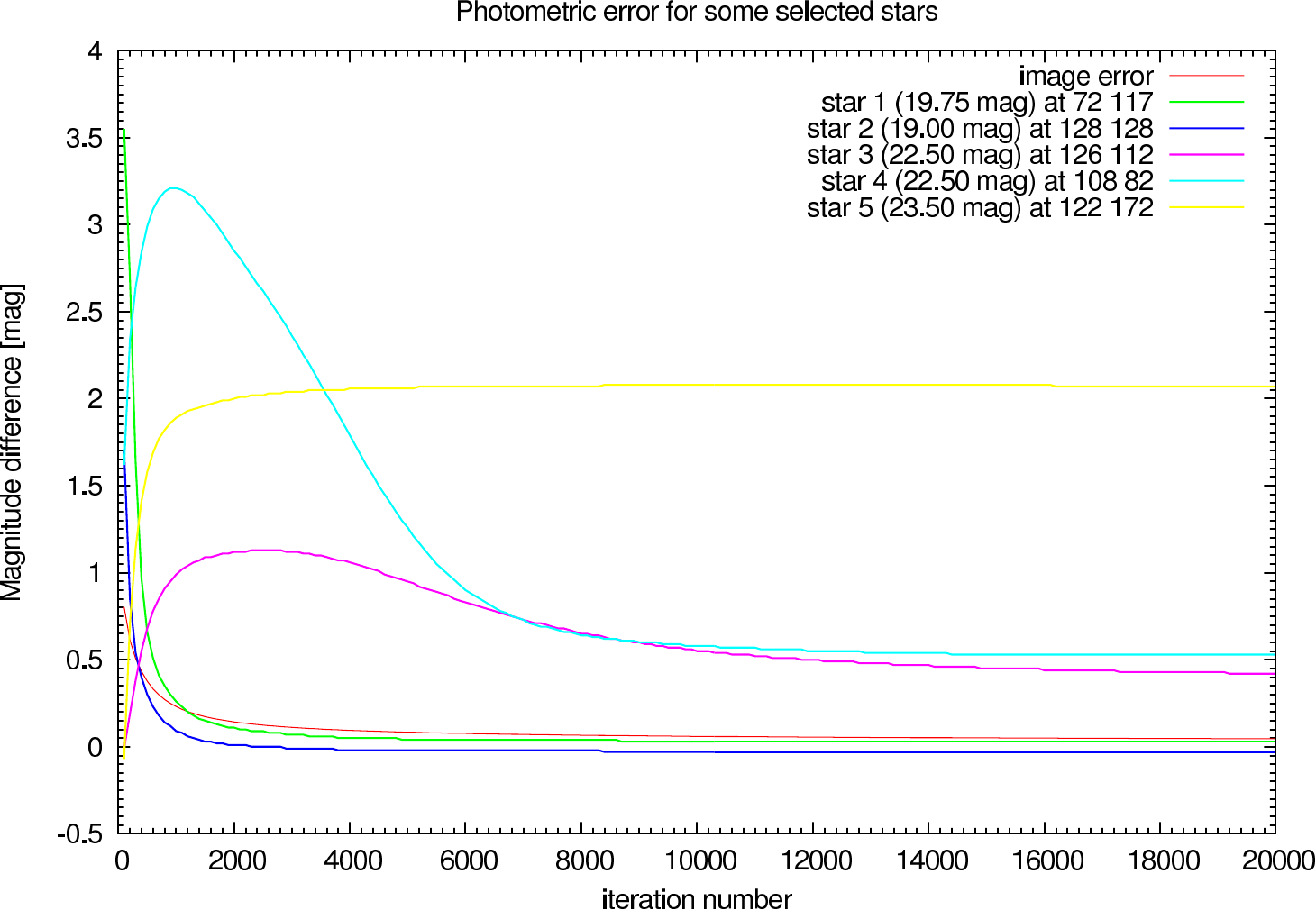 |
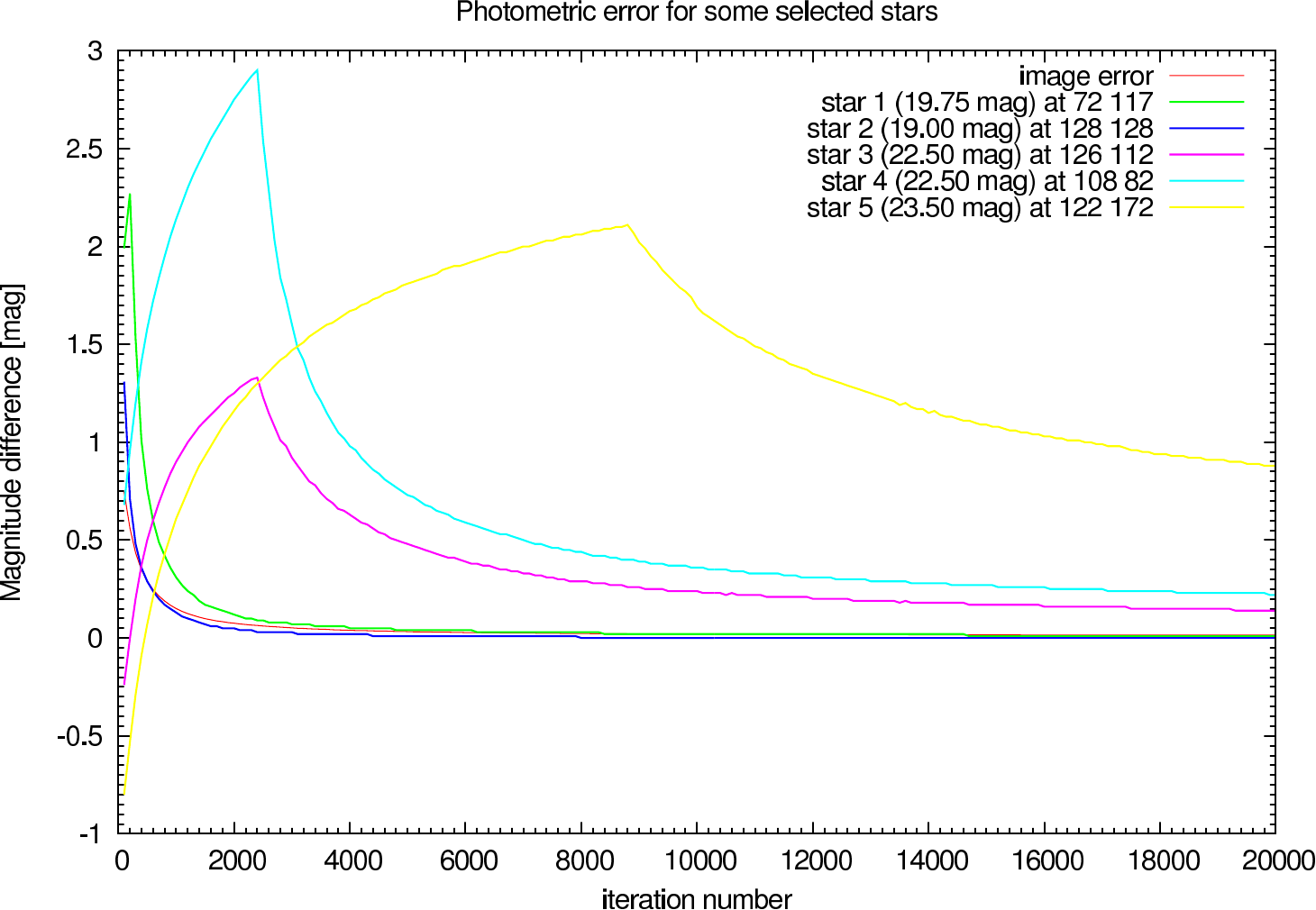 | 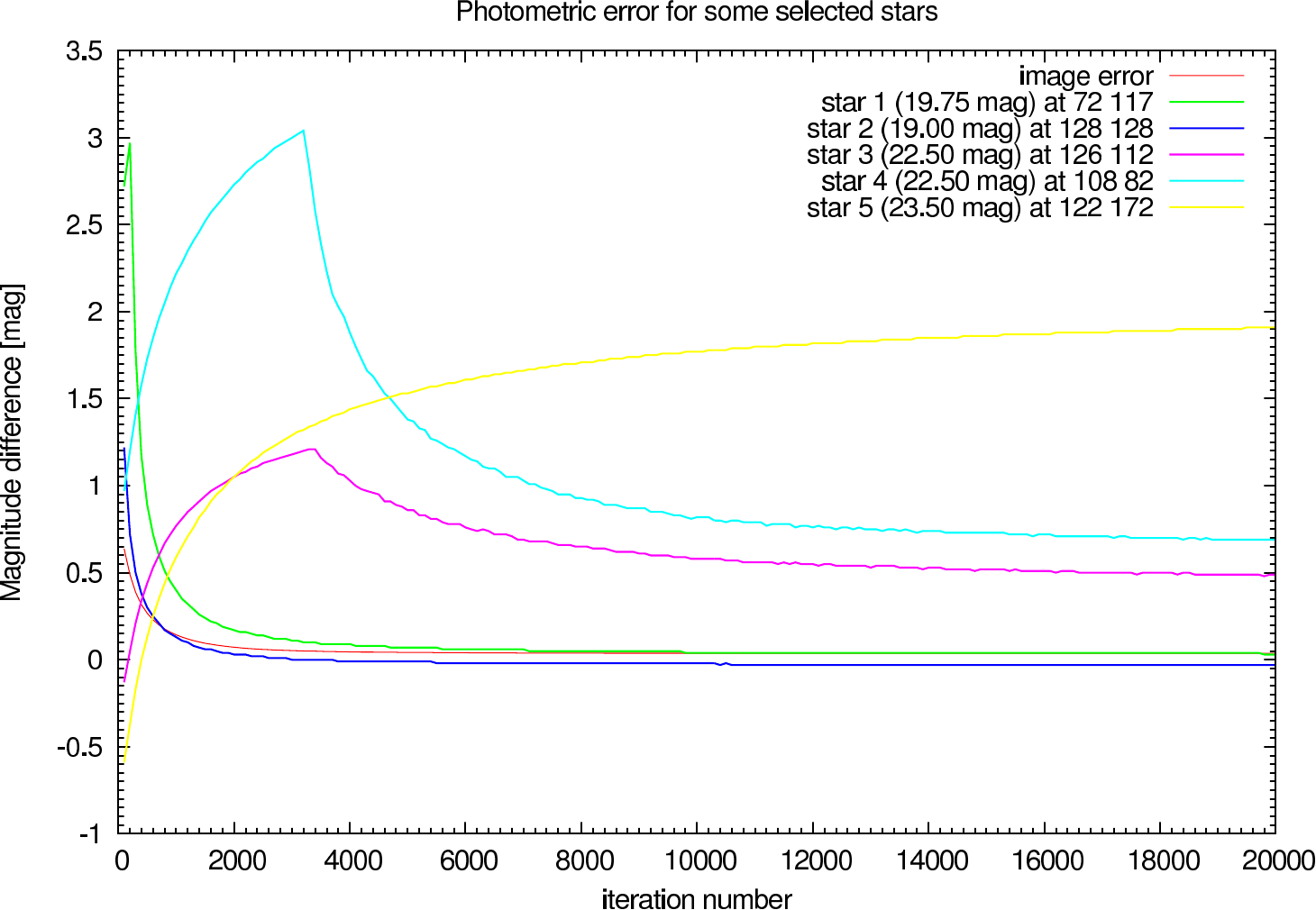 |
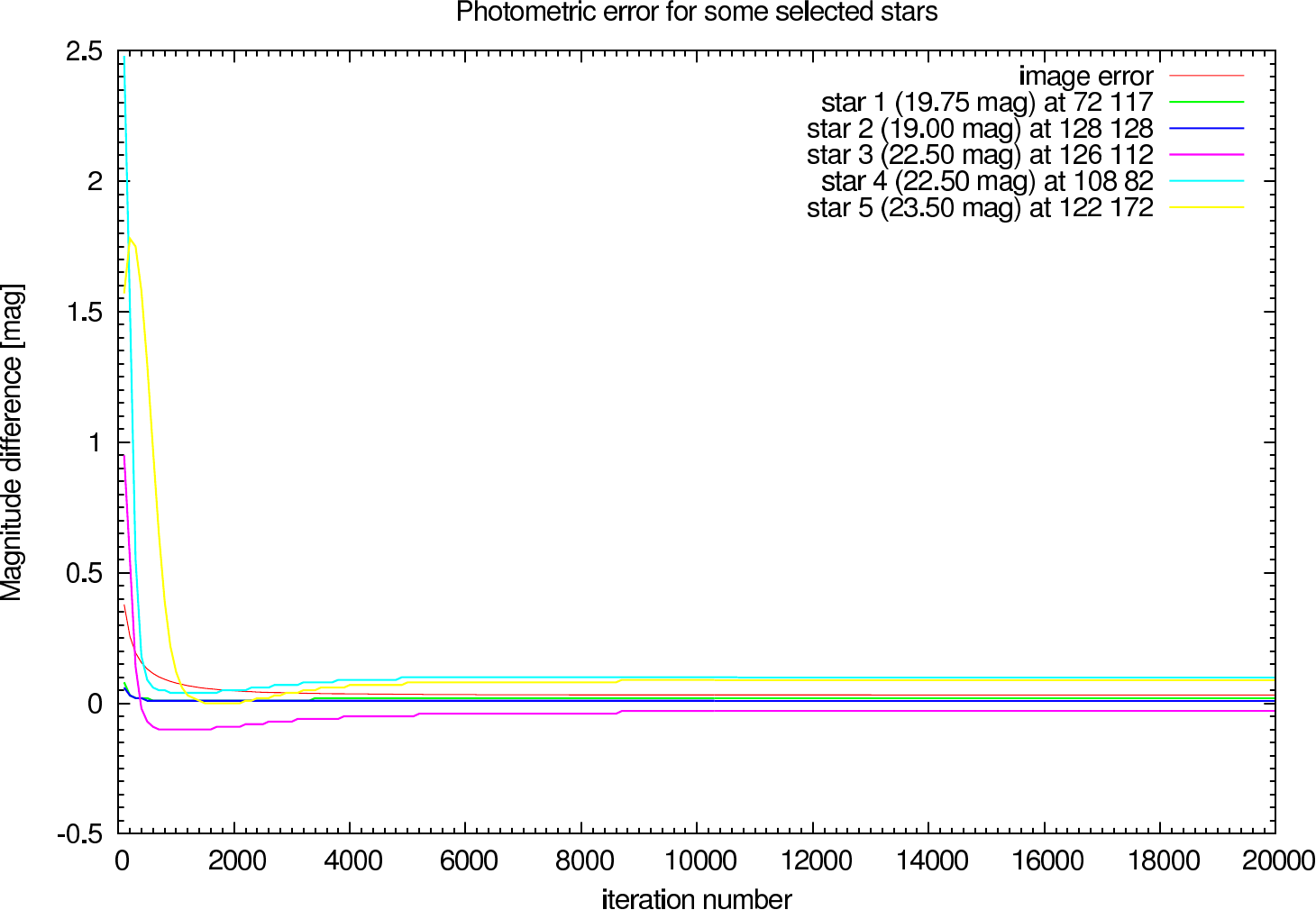 | 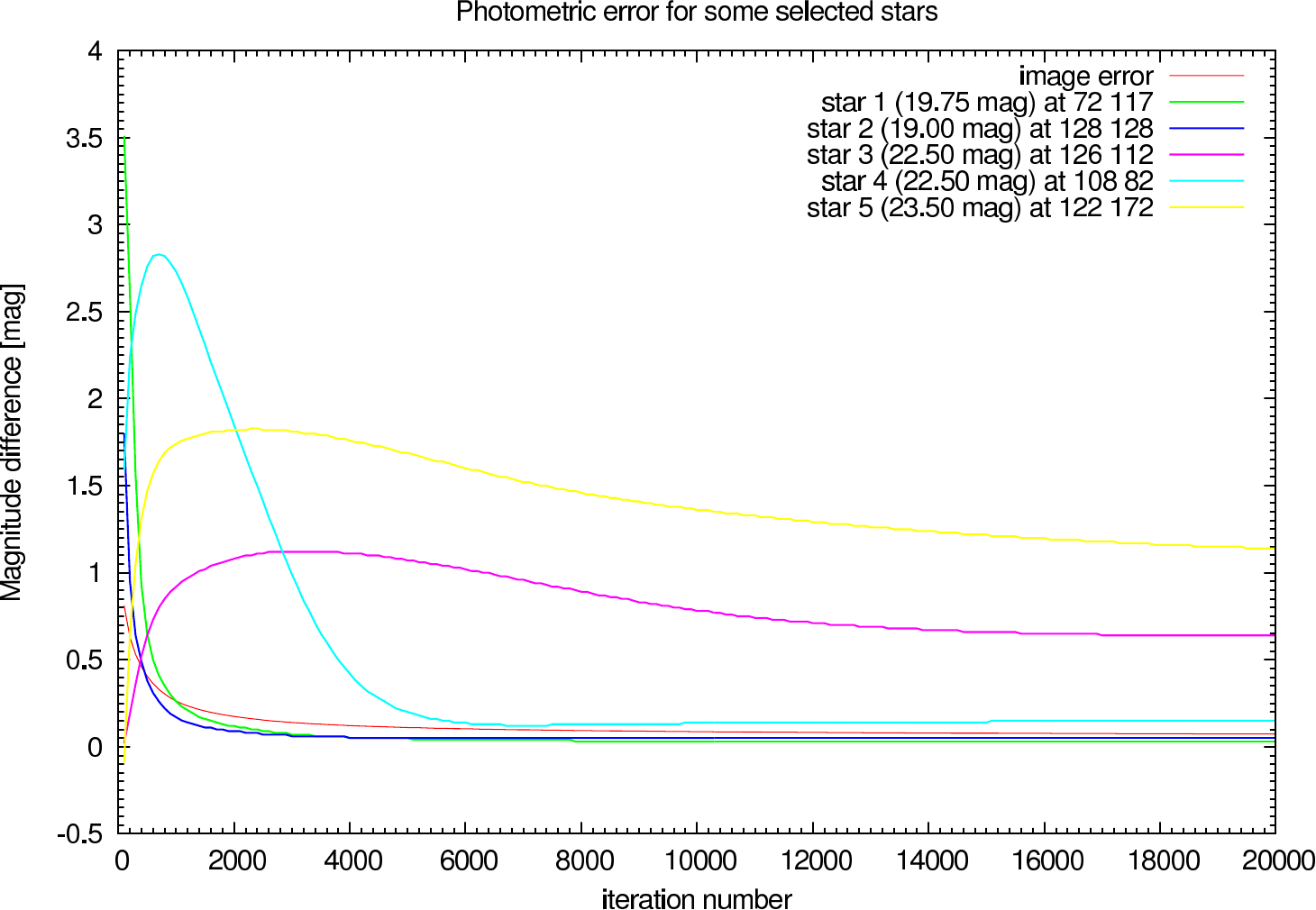 |
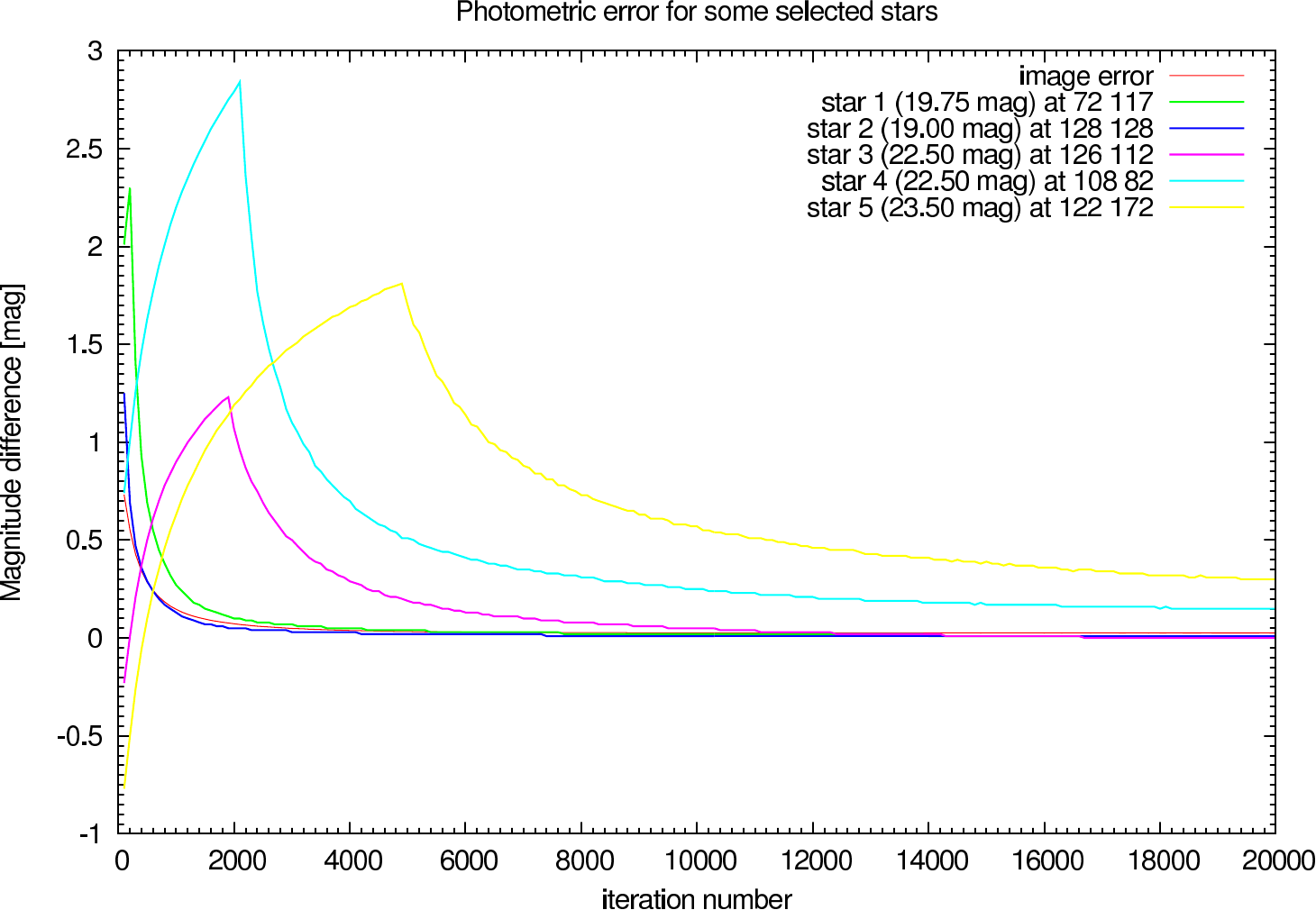 | 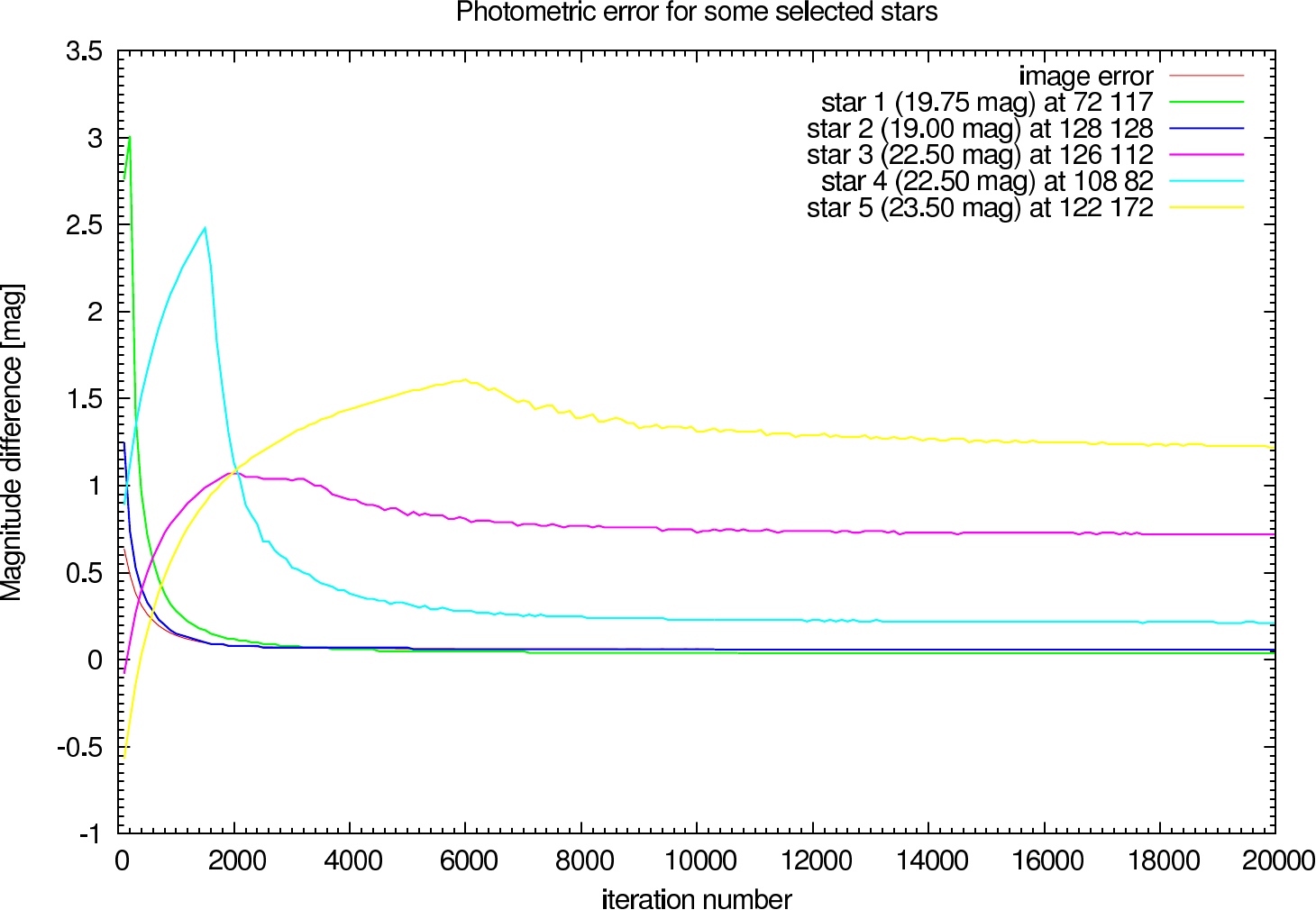 |
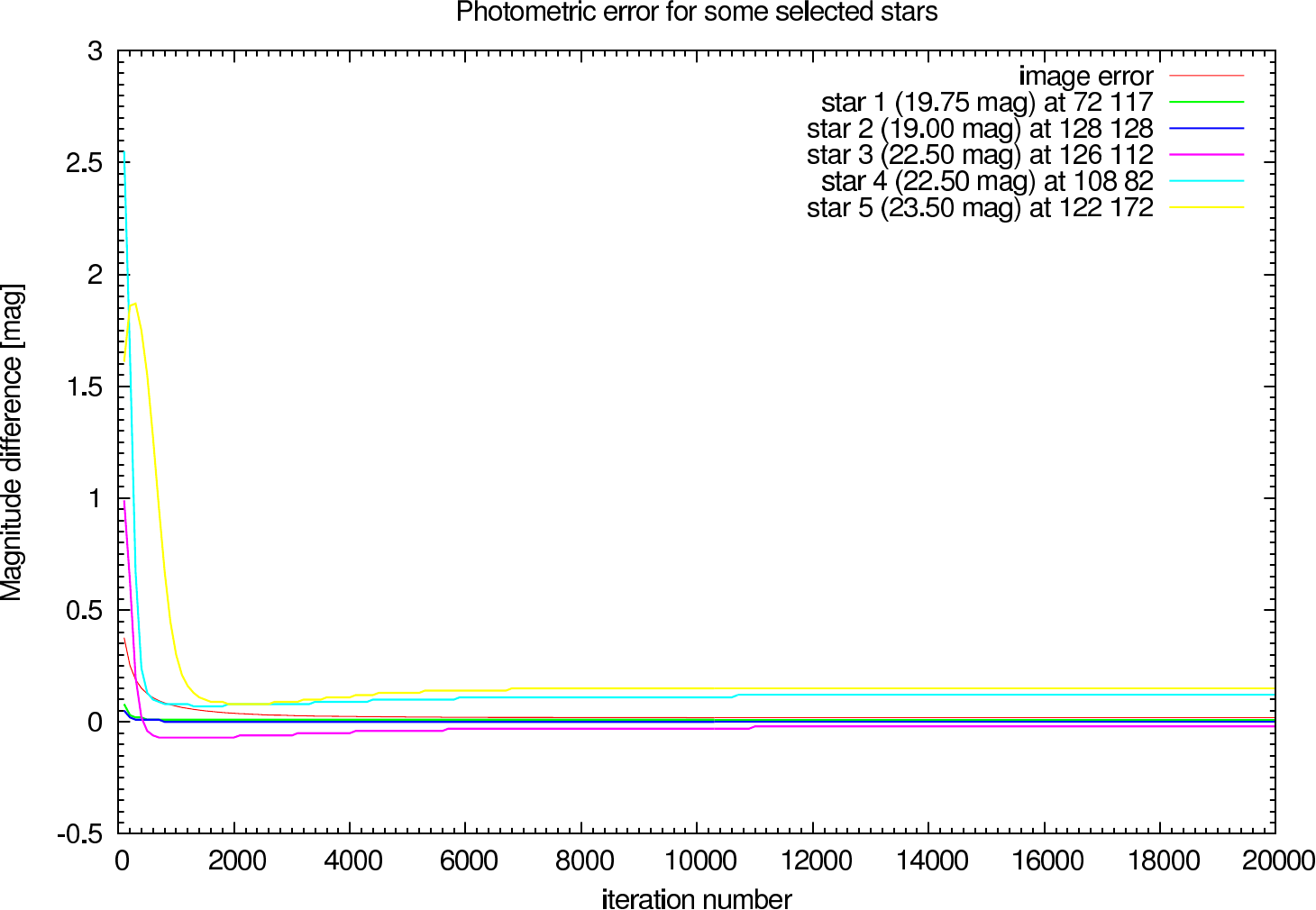 | 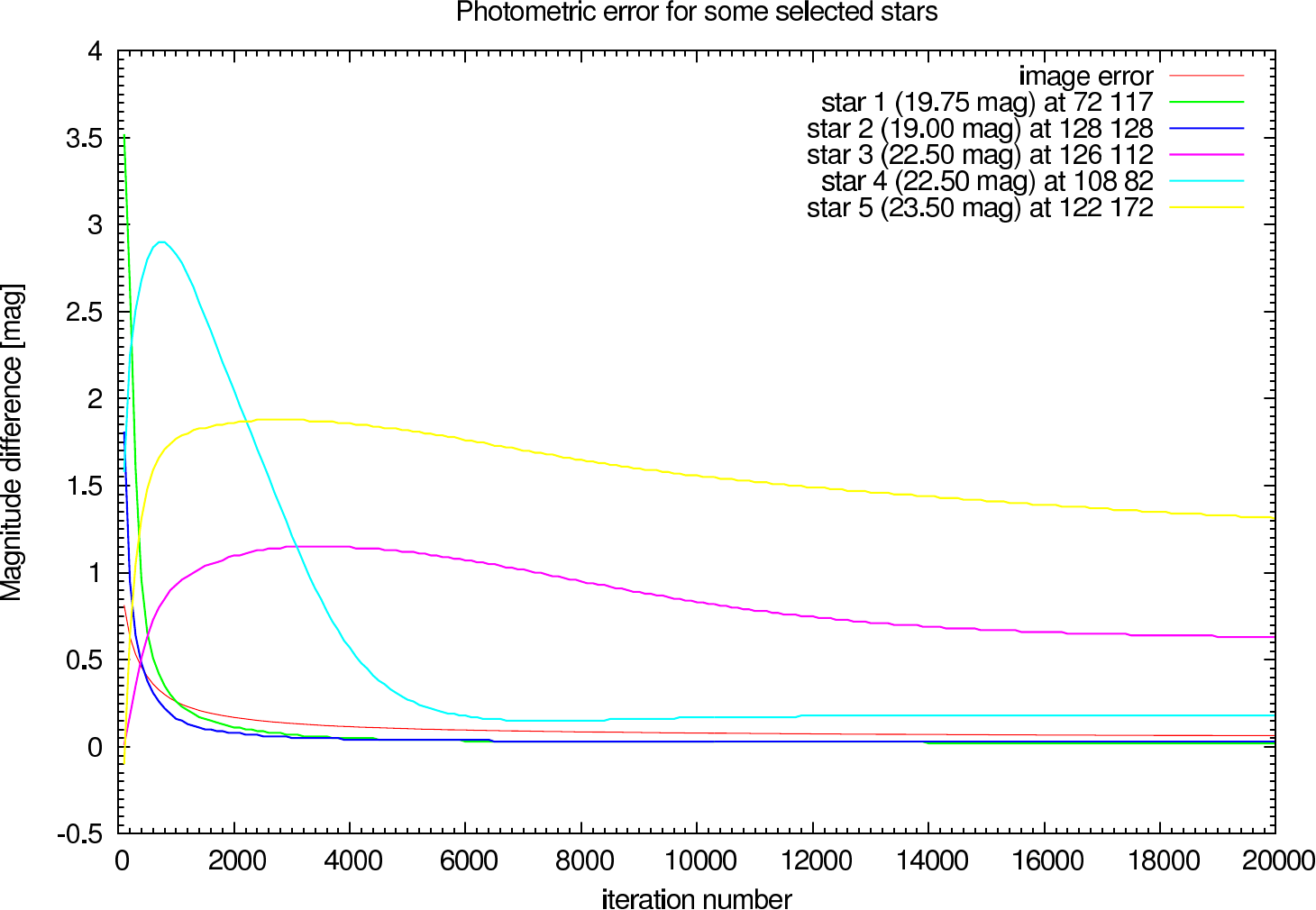 |
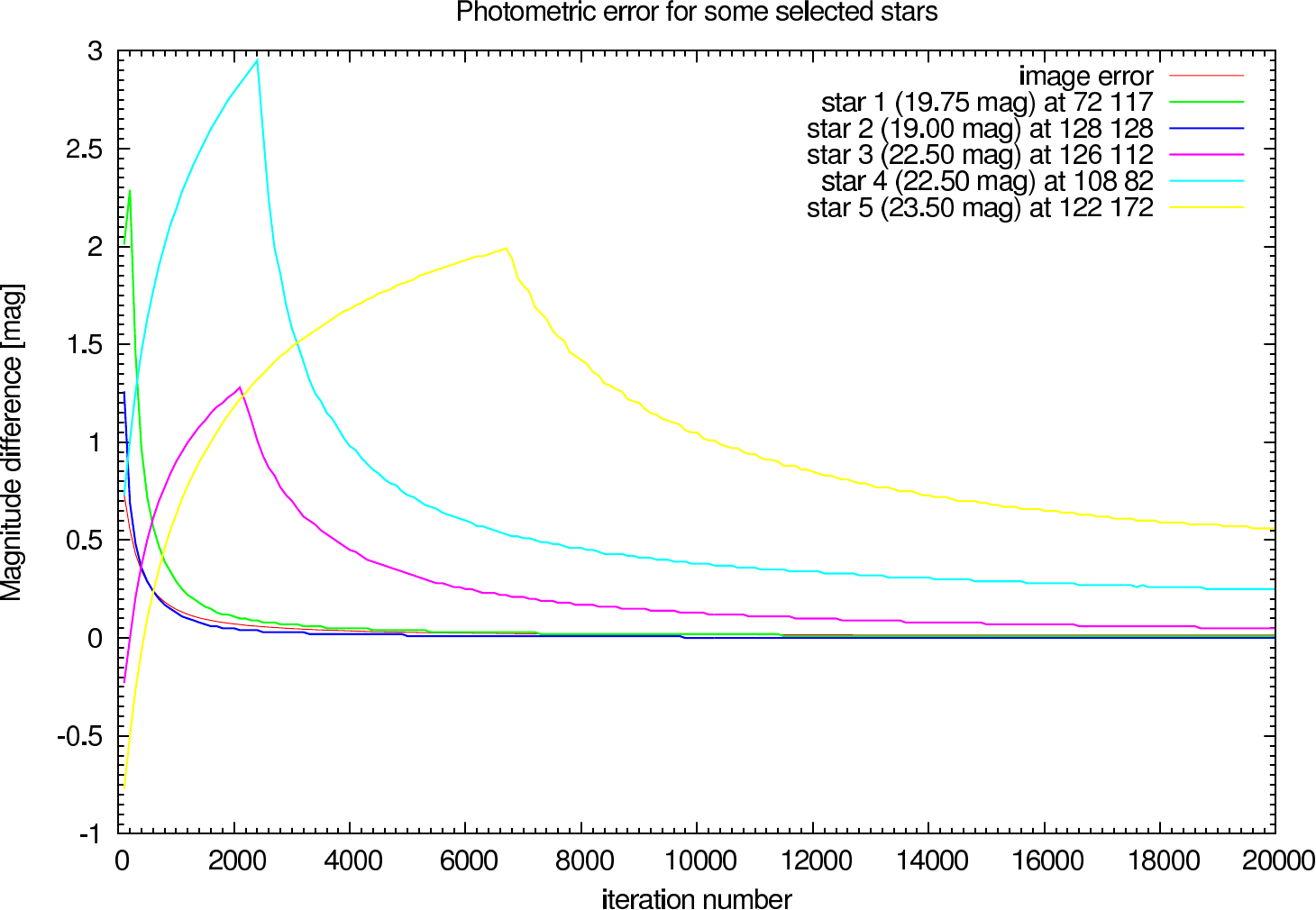 | 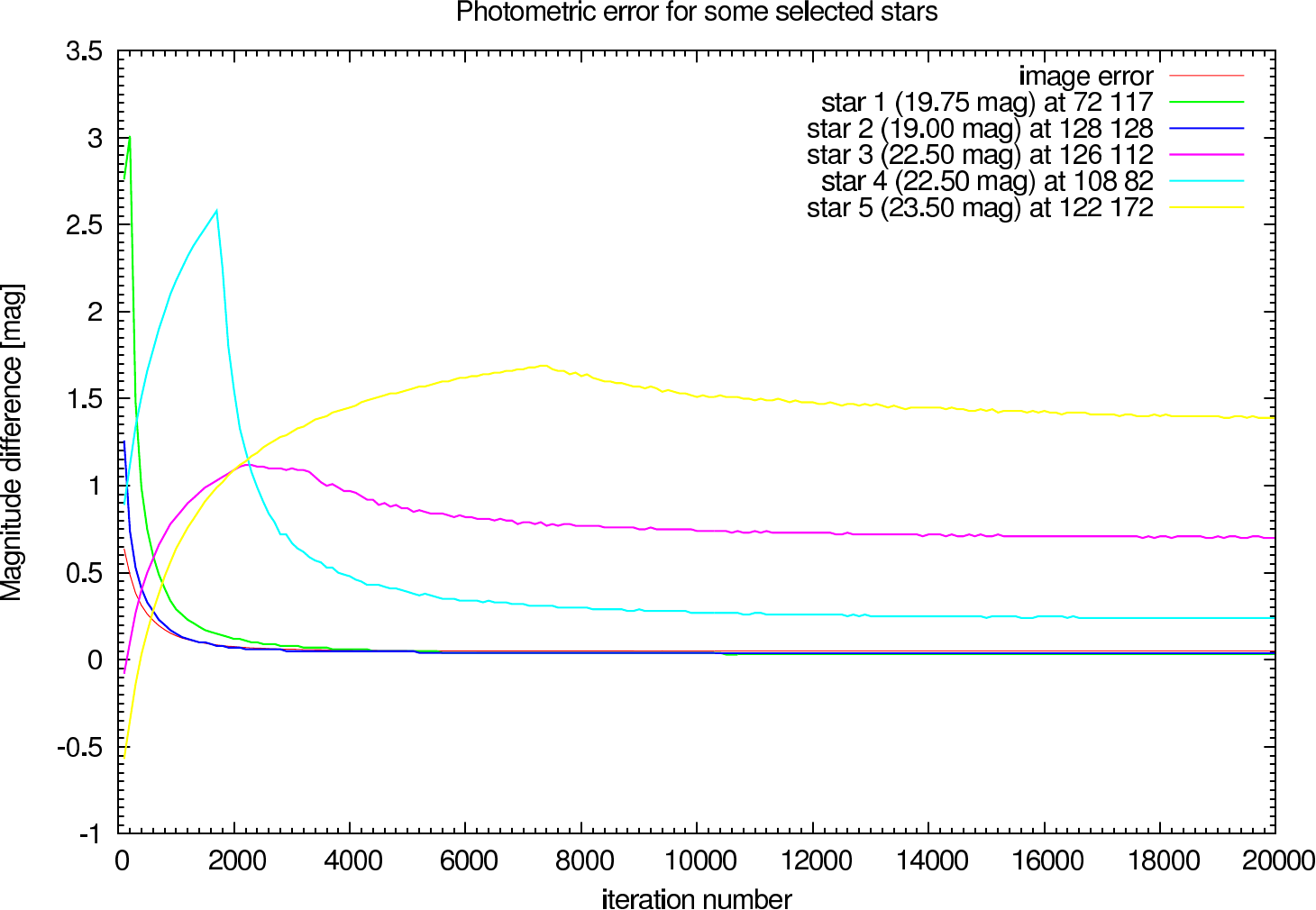 |
In table 4 (J-Band) and table 5 (K-Band) the errors for the star cluster depending on the target and calibrator spectrum are presented.
| Testcase | Richardson-Lucy | Building-Block | |||||
|---|---|---|---|---|---|---|---|
| Spectrum (T) | Spectrum (C) | Image Error | Magnitude Error | Position Error | Image Error | Magnitude Error | Position Error |
| 0.0 0.0 | 0.0 0.0 | 0.019 (0.019) | 0.02, 0.01, -0.00, 0.06, 0.13 | 0.01, 0.01, 0.13, 0.07, 0.53 | 0.014 (0.014) | 0.01, 0.00, 0.04, 0.09, 0.34 | 0.00, 0.01, 0.05, 0.03, 0.17 |
| 0.0 0.0 | 0.0 0.1 | 0.015 (0.015) | 0.02, 0.01, 0.00, 0.06, 0.16 | 0.01, 0.00, 0.09, 0.06, 0.59 | 0.012 (0.012) | 0.01, 0.00, 0.05, 0.12, 0.44 | 0.00, 0.00, 0.04, 0.01, 0.15 |
| 0.0 0.0 | 0.0 0.2 | 0.013 (0.013) | 0.01, 0.00, 0.02, 0.07, 0.17 | 0.01, 0.00, 0.03, 0.04, 0.55 | 0.014 (0.014) | 0.01, -0.00, 0.14, 0.22, 0.88 | 0.00, 0.00, 0.07, 0.01, 0.11 |
| 0.0 0.5 | 0.0 0.0 | 0.032 (0.032) | 0.02, 0.01, -0.03, 0.10, 0.09 | 0.01, 0.01, 0.04, 0.33, 0.37 | 0.026 (0.026) | 0.01, 0.01, -0.00, 0.15, 0.30 | 0.01, 0.01, 0.02, 0.22, 0.17 |
| 0.0 0.5 | 0.0 0.1 | 0.027 (0.027) | 0.02, 0.01, -0.03, 0.11, 0.12 | 0.01, 0.02, 0.05, 0.31, 0.28 | 0.022 (0.022) | 0.01, 0.01, -0.00, 0.16, 0.35 | 0.01, 0.01, 0.02, 0.19, 0.09 |
| 0.0 0.5 | 0.0 0.2 | 0.018 (0.018) | 0.01, 0.00, -0.02, 0.12, 0.15 | 0.01, 0.01, 0.06, 0.28, 0.23 | 0.014 (0.014) | 0.01, 0.00, 0.05, 0.25, 0.56 | 0.01, 0.01, 0.02, 0.06, 0.06 |
| Testcase | Richardson-Lucy | Building-Block | |||||
|---|---|---|---|---|---|---|---|
| Spectrum (T) | Spectrum (C) | Image Error | Magnitude Error | Position Error | Image Error | Magnitude Error | Position Error |
| 0.0 0.0 | 0.0 0.0 | 0.050 (0.050) | 0.03, -0.02, 0.43, 0.46, 1.88 | 0.05, 0.03, 1.19, 1.62, 0.50 | 0.038 (0.038) | 0.04, -0.02, 0.47, 0.56, 1.88 | 0.03, 0.03, 1.00, 1.54, 0.33 |
| 0.0 0.0 | 0.0 0.1 | 0.048 (0.048) | 0.03, -0.02, 0.37, 0.47, 1.97 | 0.04, 0.03, 1.17, 1.56, 0.12 | 0.035 (0.035) | 0.04, -0.02, 0.41, 0.57, 1.90 | 0.01, 0.03, 1.00, 1.43, 0.45 |
| 0.0 0.0 | 0.0 0.2 | 0.047 (0.047) | 0.03, -0.03, 0.42, 0.53, 2.07 | 0.04, 0.03, 1.37, 1.60, 0.41 | 0.037 (0.037) | 0.03, -0.03, 0.49, 0.69, 1.91 | 0.01, 0.03, 1.15, 1.46, 0.44 |
| 0.0 0.5 | 0.0 0.0 | 0.073 (0.073) | 0.03, 0.05, 0.64, 0.15, 1.14 | 0.05, 0.05, 2.14, 1.04, 2.30 | 0.061 (0.061) | 0.04, 0.06, 0.72, 0.21, 1.22 | 0.03, 0.05, 2.08, 0.99, 2.35 |
| 0.0 0.5 | 0.0 0.1 | 0.072 (0.072) | 0.03, 0.05, 0.60, 0.16, 1.05 | 0.06, 0.06, 1.97, 1.02, 2.36 | 0.059 (0.059) | 0.04, 0.05, 0.67, 0.22, 1.19 | 0.04, 0.06, 1.87, 0.98, 2.79 |
| 0.0 0.5 | 0.0 0.2 | 0.064 (0.064) | 0.02, 0.03, 0.63, 0.18, 1.31 | 0.05, 0.07, 1.79, 1.04, 1.94 | 0.050 (0.049) | 0.03, 0.04, 0.70, 0.24, 1.39 | 0.03, 0.06, 1.68, 0.98, 2.09 |